2013 West Asia
Expedition to West Asia
During my first trip to West Asia I decided to travel around the Caucasus and Iran. The journey through the countries of the Caucasus was my continuation of expeditions in the former republics of the Soviet Union. In 2010, I crossed the countries of Central Asia, and I liked it so much that I was curious to see, what life looks like on the other side of the Caspian Sea. I traveled to Georgia, Armenia, Azerbaijan and Nagorno-Karabakh. Then I traveled through the beautiful and historically rich Persia, which proved to be the ultimate adventure. According to the Zionist legends Iran belongs to the ‘Axis of Evil’, because it is rich in oil and gas, and it is not yet controlled by the globalist (Jewish) banking system.
Introduction to West Asia 2013
My expedition this year was completely different than all the others I had so far. In previous years I travelled through the beautiful South-East Asia but this time I went to the Caucasus and then to Iran. In the Caucasus countries I went to Georgia, Azerbaijan, Armenia and Nagorno Karabakh. I planned my trip for 2.5 months but at the end I stayed 3 months and I also managed to visit Turkey.
Please be sure to read the section at the end where in very honest words I discussed the Armenian genocide carried out by the Turks and the “axis of evil”. These topics became parts of my trip.
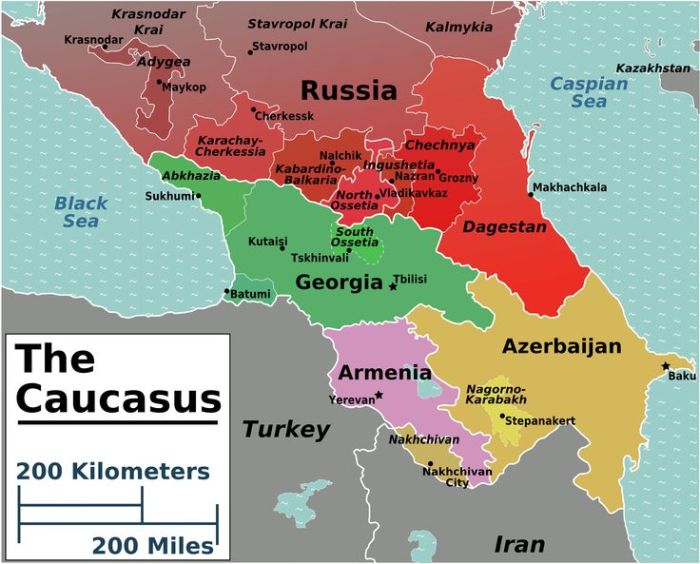
The map of Caucasus.
Georgia
I started my trip from Caucasus, that’s why on the 14/08/2013 I left Warsaw for Georgia where I travelled around 3 weeks. Georgia is attractive to tourists in many ways, of which the best are ancient churches built in the mountains and sometimes also by picturesque lakes. In addition to good conditions for beautiful landscape photos Georgia also offers mountaineering expeditions to the wild places and a destination for those who enjoy close contact with nature, who like to sleep in tents and make their own fires, and more ambitious tourists can also conquer peaks and glaciers.
I began my Georgian adventure from the town of Kutaisi. Kutaisi is the second largest town in Georgia and for many visitors it is also the first contact with the country because of the cheap flights. However, compared with the capital Tbilisi, Kutaisi is a very small and attractive town because it offers interesting history and scenic views of the Bagrati cathedral. As the town town I think that Kutaisi is an ideal place for contact with the Georgian culture, with good people and good hinkali dumplings, with the richness of cheeses and also with some interesting monasteries.
My first trip outside Kutaisi was to the Gelati monastery situated in the picturesque mountainous landscape. It was built in the early twelfth century and throughout the centuries of its existence it served not only as a church but also as the burial place of kings. Later the Gelati monastery was burned in the sixteenth century by the Ottomans and in the twentieth century communists expelled priests and closed the church. Today however Gelati lives its life to the fullest, also because of its attractiveness to tourists.
Then I walked down the winding road past the houses and orchards. Pomegranates where growing by the road which are very common in Georgia but also grapes which gave the home owners some shade. After about a 6km march I reached the monastery of Motsometa which is just another journey in time to the architectural splendour of Georgia and which is set in natural beauty. Motsometa is more delicate and built of smaller stones, it is covered with red tiles and has a nice tower with a cross on top.
My last trip from Kutaisi was tp a cave of Prometheus and it was a display of stalactites, stalagmites, petrified waterfalls, underground rivers and small lakes. Prometheus Cave in Georgia is worth a visit because it proves to visitors that nature can create beautiful art.
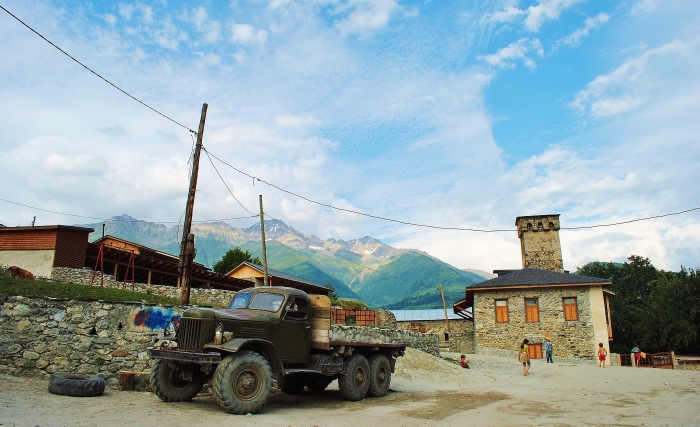
Georgia; Mestia – a truck in front of the mountains and the traditional tower.
Among the many mountain trips which I took in Georgia I still have the best memories from my first. I went to the town of Mestia in Svaneti which although it is a well-known tourist centre it gives an opportunity of retreat, meetings with interesting people and a history lesson because of its distinctive towers built to defend against the Mongols. Mestia is a town built of mountain rocks, wooden fences, homely kitchen and despite growing tourism still gives a feeling of pleasant, rural atmosphere. While there I went on a journey through the mountains to the Chalati glacier what turned out to be a unique adventure. I went through the mountain slopes, I walked along a rushing river and then went out into the open rocky area, and at the end I had a glacier. Then I pitched a tent, I set my own fire and I spent the night in the mountains. The second expedition was an exhausting climb to the Kuruldi lakes and even though that lake itself was not special the view of yellow flowers and grazing cattle in the background of snow-capped Caucasus mountains were worth my effort. I have a lot of such stories.
After the mountain trips I went to Kobuleti which is a small town by the Black Sea and which I recommend to those who don’t want to stay in loud Batumi. Kobuleti is much smaller, quieter and it is easier to relax over there. It is also good to add that the beach in Kobuleti is rocky and the waves are high and strong. You need to be careful. Of course whilst in Kobuleti I organised a few trips. For example, I went to the Batumi Botanical Gardens which cover 111 hectares and are located in the Green Cape on the Black Sea. It is a very rich, beautiful and an extremely diverse park which is also the largest of all of the former Soviet Union. The gardens are divided into many geographical sections meaning that there is plenty of vegetation from South America, Australia, New Zealand, Asia, Mexico, the Mediterranean and the Caucasus. This ensures that every part of the park is quite different because the vegetation takes us to different continents. The Batumi Botanical Gardens are rich in colours and variety of skillfully designed sections of light and shadows as well as ponds and tree roots appearing from the forest trail. Then I went to the famous Batumi which is a popular tourist town of Georgia and an important port on the Black Sea and the capital of the autonomous region of Adjara. Batumi is located in subtropical climate and even though the main branches of its economy are citrus fruit, shipbuilding and food processing, the president of the city puts great emphasis on tourism. Batumi is close to Turkey and it annually draws many tourists from there and from the countries of the former Soviet Union. In addition, with a population of nearly 200,000 and a long beach and a very well-developed tourism Batumi is not that tiring compared to other major cities. Since the collapse of the Soviet Union the panorama of Batumi has changed. There are many good hotels and restaurants and modern buildings by the sea, the renovated Old Town and a promenade just by the sea. Apart from that Batumi is decorated with tropical vegetation and interesting sculptures and art. While there, be sure to take a stroll along the beach or on the 1.5km promenade called Batumis Bulvari but be warned that the beach is rocky and the waves can be very strong.
Then I went another 11km towards Turkey to see a very well-preserved Roman Gonio fortress with a beautiful garden in the middle. The fortress has 18 towers and a defensive wall on which I walked as well as a Roman bath and a theatre. The plants were very impressive. Those who want to go to the Turkish border in Sarpi have another 6km.
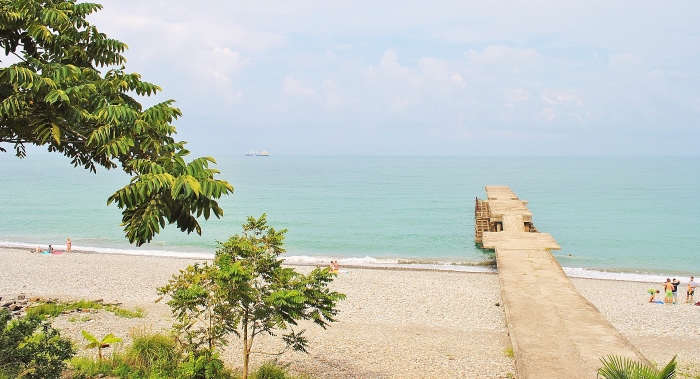
Georgia; Black Sea seen from the Batumi Botanical Gardens.
Then I was driven by about 30-year-old Lada Niva through the mountains which broke down many times. I stayed in many charming and very boring places but God finally wanted to end of my trip in the village of Lododziri, which Georgians themselves probably never heard of. I was going to spend the night in a tent but me and my colleague were invited by a local home owner Hasan, who had at his disposal two obedient slaves – his wife and his daughter. I have to admit that Muslims know how to establish an absolute discipline at home because on the command if the Islamist they behaved as if they exploded in the air to serve men. Besides, I never heard “please”. There was only a brutal roar. As it turned out later women would get up early and went to bed the latest because they had to serve everyone and do all the housework. Apart from Hasan,me and my friend Kamil there was also the Hasan’s neighbour who came to us to tell incredible stories. The table was full of Georgian dishes, hachapuri, many kinds of sour cheeses and of course a homemade alcohol. I didn’t drink but Kamil did as usual and that’s why he saved the honour of Poland by getting drunk with them. We spent the night in a log cabin somewhere in the middle of a potato field and it was very interesting.
The next day, after hitchhiking a few times, after travelling on seats and in a big trunk, finally at the end of the day we reached the town of Akhaltsikhe. The only attraction over there was Rabati, a restored castle from the XII century with ramparts, museums, churches, synagogue and a mosque which stands on the top of a mountain and dominates the view of Akhaltsikhe. Rabati is a huge and a well-kept building which takes us to the times of medieval Georgia. I walked there on ramparts, I climbed the towers and I saw an exhibition of old Caucasian carpets and sixteenth century manuscripts. Then a waitress in a bar mixed us with mud because she thought that we no longer had money to pay for a meal, although we were not generous too. From Ahkalstikhe I went on a trip to the cave city of Vardzia which is the largest of its kind in Georgia and also closely related to the culture and history of Georgians. Vardzia is a massive structure carved in the rocks, with a lot of caves, tunnels, chapels and a bell tower which cost oceans of hard work and which has been continuously one of the cultural symbols of Georgia from the twelfth century. Because of its size the whole structure was created for centuries and more precisely by the new generations of the Royal Family. Vardzia was started as a fortification by Giorgio III in the twelfth century and it was continued as a place of Christian worship by his daughter Queen Tamara. Looking at Vardzia from a distance the whole structure amazes with its size because I’m talking about a huge rock wall that was grooved into a big city and consisting of 13 floors. To better understand the magnitude of Vardzia it is worth noting that its two parts are divided by a church carved into the rocks, where the eastern part has 242 rooms in the western one 165. On the way to Vardzia I stopped for a moment to admire the ruined Kvertisi castle, built on a rock between the X and XIV century and which beautifully dominates the mountain landscape. From Ahkalstikhe I also went to the Sapara Monastery built about ninth century, surrounded by mountains and beautiful vegetation and at the same time strategically located on the edge of the cliff and far away from civilization.
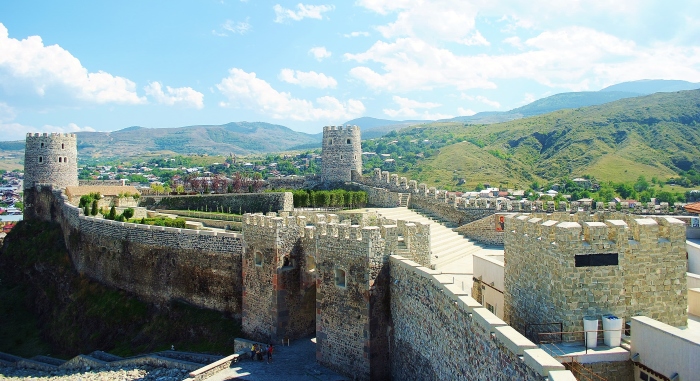
Georgia; Rabati castle in Ahkalstikhe.
My next stop was historic Tbilisi, which has been continuously the capital of Georgia from almost V century. Tbilisi is the centre and the political, cultural, social and economic life of the country and the place which every Georgian identifies. Tblisi lies on the river Mtkvari and boasts with the historic Old Town with its many beautiful churches, streets full of restaurants and art but also the fortress towering over the city. On the other hand Tbilisi is also a city which architecturally flows into the twenty-first century and at the same time retaines its traditional Christian culture and supportive relationship with the former Soviet Union. The symbol of the town is the Metekhi church and the statue of King Gorgasali though the Old Town offers much more. The rest of the monuments are very close to each other. Tbilisi is also known for its bath but for me it was a “club of a wet faggot.” I did not feel comfortably over there but fortunately there are also baths for couples.
Of course from Tbilisi I also organised a few trips. About 72km from Tbilisi there is Ananuri castle built in the thirteenth century and which lies in a picturesque location on Aravgi river. Ananuri is a compulsory visit which gives an opportunity of beautiful pictures. 80km from Tbilisi there is city of Gori which is the birthplace of Joseph Stalin. It is a very interesting and a very hypocritical museum showing Stalin as a good uncle, even though he was one of the greatest murderers of all time. Interestingly Georgians are proud of him and don’t want to acknowledge that he used to murder them too. From Gori I went to Uplistsikhe, another rocky city which is one of the oldest human settlements in the Caucasus. In the Middle Ages Uplistsikhe was a strategic location between the forests and the deep valleys and during its heyday about 20,000 people used to lived there.
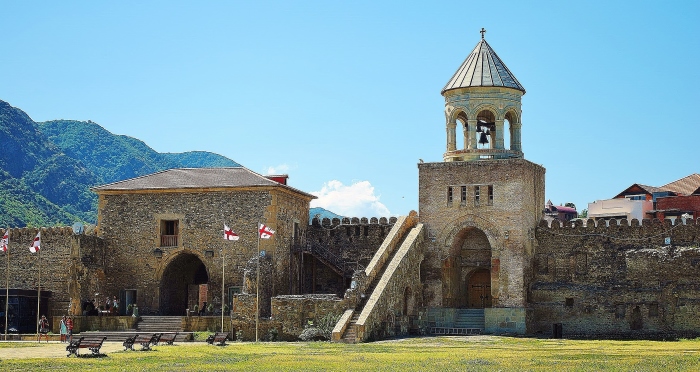
Georgia; Mtskheta – the former capital of Georgia and today a town of historic churches and beautiful nature.
Not far from Tbilisi lies Mtskheta which is an important cultural heritage of Georgia. That small town has one of the oldest and most important churches in the country and was the capital of Georgia from the third century BC to the fifth century AD. Mtskheta is such a historically and culturally important place that even after the king Vakhtang Gorgasali moved his capital to Tbilisi in the fifth century, Mtskheta was still the religious capital of Georgia and the seat of the Georgian Orthodox Church. Besides, Mtskheta is picturesquely located at the junction of rivers Aravgi and Mtkvari and its traditional architecture is made up of small houses covered with vines. From there I went by taxi to the Jvari church which is one of the most sacred churches in Georgia and also one of the oldest one. It was built in the sixth century and stands on top of a mountain what is clearly visible from Mtskheta.
My last trip was from Tbilisi was to the rock city of Davit Gareja what turned out to be an adventure in transport. Davit Gareja lies on the border with Azerbaijan and I got there by hitchhiking through a rough land which was once a military training ground. Davit Gareja is a small rock town consisting of rooms and chapels carved in the walls and with frescoes dating from the X and the XIII century. It is also important to note that Davit Gareja is not only about churches and caves but also about beautiful landscapes which tourist should enjoy too. Driving by a rusty old car through the wilderness and the solitude of this place on the crossroads of Georgia and Azerbaijan were at least for me a huge attraction.
Then I went to Kazbegi, a small town 3h from Tbilisi which is very popular among tourists because of the old XIV century church on the top of a mountain called Tsminda Sameba. Therefore, the next morning I climbed the mountain to the church Tsminda Sameba which today is a symbol of Georgia and it is on so many postcards that everybody knows it well. The march up the mountain took us 1.5h and I admit that for a mountain trail there was a lot of traffic because the whole village went up. All tourists went up, all locals went to pray in the church and also the old, fat women to ask for change in the church. The trail trail itself was easy and pleasant and at the altitude of the church there was a plateau where Georgians camped and gave some food and young boys offered horseback riding.
Climbers who have the equipment and fancy a longer climb can continue to Mt. Kazbek 5034 m above the sea level.
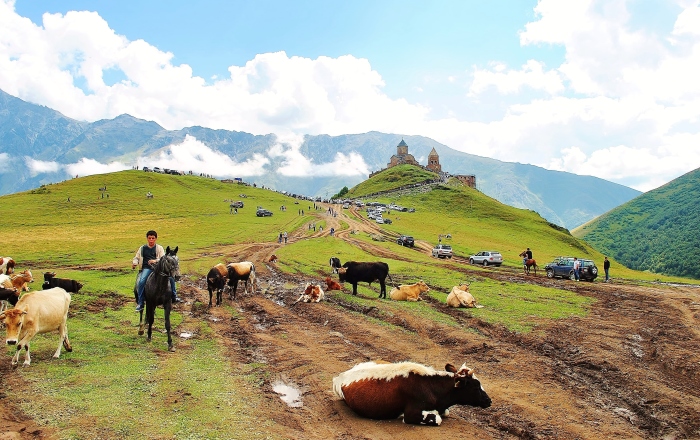
Georgia – the view of Kazbegi monastery.
My last place worth describing was Sinhnaghi, a very nice small town with historic buildings, which is the main tourist town of Kakheti and which in addition to several historic buildings has a nice atmosphere, scenic views and omnipresent vines. Two-thirds of the buildings in Sinhnaghi date from the seventeenth, eighteenth and the nineteenth centuries and today thanks to the restoration works they are in great shape. In addition Sinhnaghi is surrounded by a 4km wall and has a few nice churches. As for the vines I advise to go there in October when a wine festival takes over one week. From Sinhnaghi I went by various transportation to the border with Azerbaijan and stayed in a few uninteresting small towns, including Marneuli which I recommend because of the people.
I definitely recommend Georgia for adventurous, healthy and Christian holidays. More ambitious travellers I advice a mountain expedition around Kakheti.
Azerbaijan
Then I went to Azerbaijan where I spent about 10 days, and if not the price of the visa I would remember this country even better, although on the other hand I’m glad I was able to get it anyway. Azerbaijan is famous for its bureaucracy and expensive, difficult to obtain visas what in my point of view means a great loss to both tourists and Azeris. To me Azerbaijan is a small Turkey, with Turkish style tea cups, with nice views, interesting architecture and handicrafts, and also with a strong dictatorship. My time spent in Azerbaijan was also a good lesson about Azeris’ opinion on Armenia and Nagorno-Karabakh. There is definitely a great hatred to the neighbours but I don’t judge them and I think I`ll leave this problem to them. In Azerbaijan people were also welcoming and eager to talk and the food was quite good, although they could give more meat to kebabs and not just a big bun. I also liked the capital of Baku where I could clearly see that the government invested a lot of money.
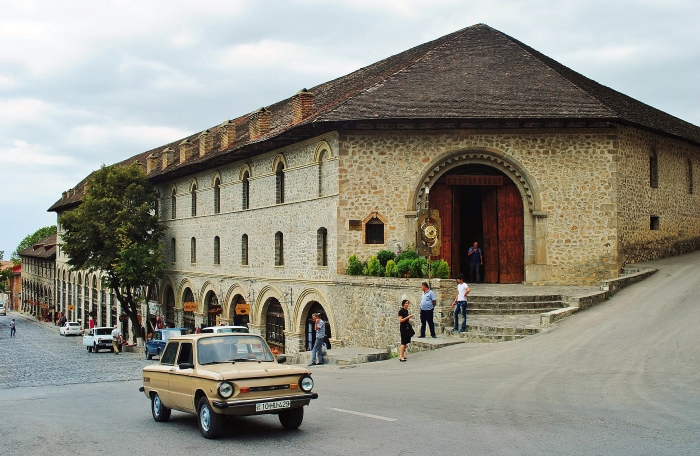
Azerbaijan – Seki town.
I entered into Azerbaijan in Lagodheki border crossing where soldiers asked me twice if I had been to Armenia and whether I was going to go. Then I hitchhiked to the nearest village of Balakan which was 14km from the border. Balakan is a typical transport hub with one park and a line of shops where travellers should stay long. My first real impression of Azerbaijan Zaqatala town where I got after the next 20 minutes. I stayed there because it was already 5 pm I didn’t want to travel at night. In Zaqatala I saw a mosque and then I went to Heydari Parki where there were several carousels and a monument to the late President Heydar Aliyev. I quickly realised that in Azerbaijan people paid more attention to a tourist because not many visited were coming and I also noticed that there were many posters depicting the former president. The cult of Heydar Aliyev in Azerbaijan is huge even though he did nothing for his country and he lost the war over Nagorno-Karabakh what forced thousands of Azerbaijanis to run away and live in poverty. Apart from that, In Zaqatala there is a small bus station and boredom.
My first true attraction of Azerbaijan was the town of Seki. Whilst there I went to the Ethnography Museum where there was a section about animals living in the area and also a part about the Second World War and the conflict in Nagorno-Karabakh; and of course each of these stories were told in a way I expected. First of all despite the occupation of Azerebaijan the Soviet Union played the role of the saviour and Stalin was described as the good uncle. It was also easy to see the racial and cultural solidarity of Turkey with Azerbaijan what was shown in a few paintings and carpets with images of Ataturk. During my trip the Azeris themselves often said that Turkey and Azerbaijan were like two brothers although I think that their “brotherhood” is based on common interests. I found the Sebaka studio to be more interesting because they made glass-stained wood. Their production requires great patience and precision of craftsmanship because it involves inserting small plastic slides in wooden groves so the geometric shapes could fit together. At the end I went to Xan Sarayi also called Palace of Khan completed in 1762. It was built in a rose garden with a pond and a massive tree. The palace is primarily a demonstration of a mosaic art which I had described earlier and painting on the walls. Xan Sarayi is certainly very impressive in terms of art and I recommend the most. Whilst in Seki I stayed with an Azeri family associated with the ministry of tourism. Locals in Seki were funny and they wanted to talk to me.
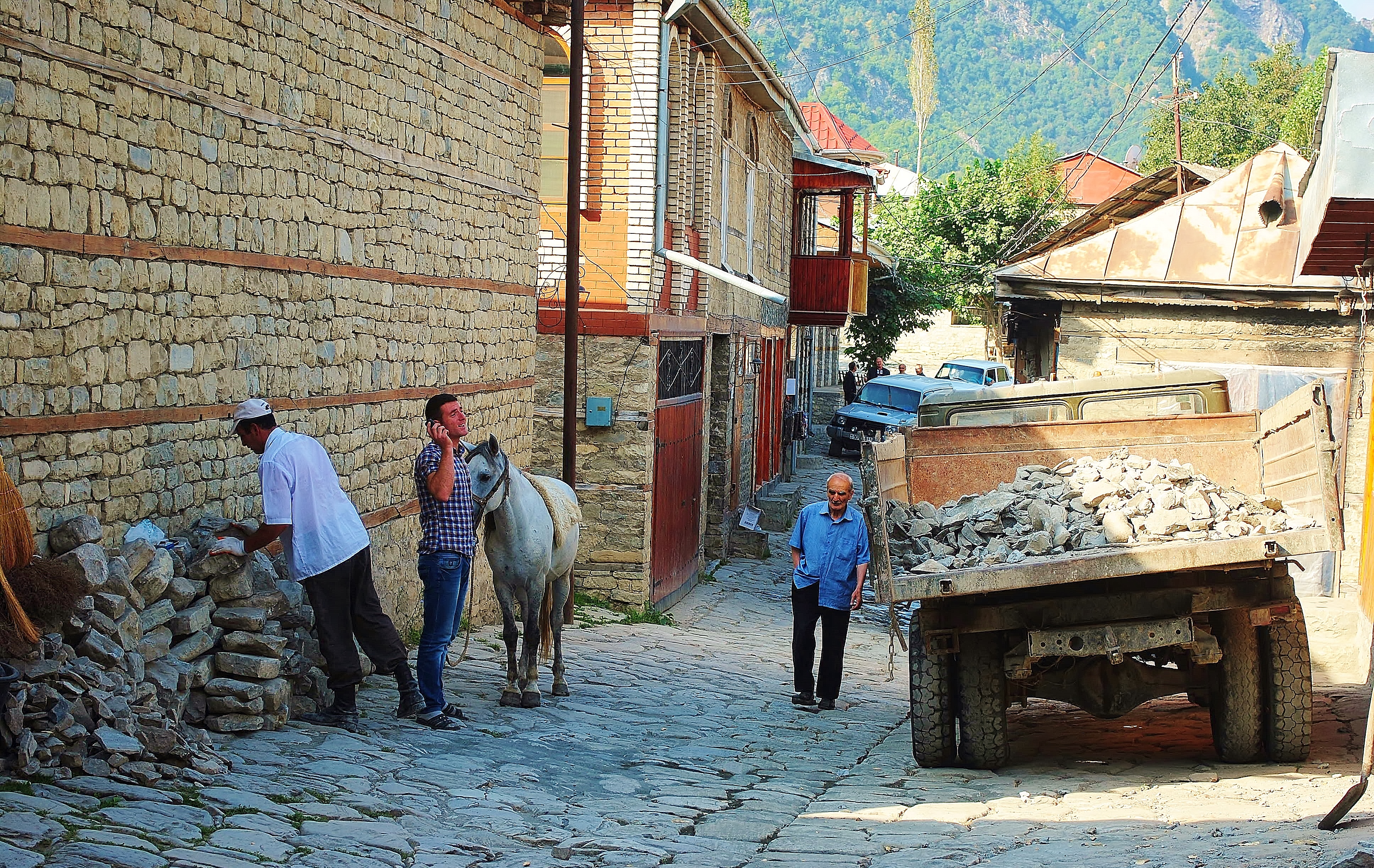
Azerbaijan – hill station Lahic.
Lahic was a more pleasant, picturesque mountain village and one of the better places in Azerbaijan to see the rural life. The specialty of local artisans are copper dishes and other objects of everyday use which can be seen in many workshops. On the main street there are also a lot of souvenir shops and local hosts open their homes to tourists and offer hiking and horse riding in the mountains. I went with my tent to the mountains towards the waterfall and I spent the night in the nature.
After Seki I easily got to Baku, the capital of Azerbaijan. Baku is in my opinion a very nice and a fast changing city. It is a combination of post-Soviet era with attractive walls of the Old Town and tall buildings made of “glass” called the Flame Towers. It is easy to sea that Baku is a monument of money because its new promenade and the pampered Old Town have gone through a very expensive plastic surgery. Baku offers good food, history and souvenirs associated with the Azeri culture (carpets, copper utensils and other). Whilst strolling through the streets of the Old Town and by passing the mosques in the colour of a desert, in a distance I saw three glass towers of sloping shapes and other attractive buildings. The social centre of Baku is the Bulvar promenade on the Caspian Sea where there are also fountains and exotic plants. It is a very pleasant and a quiet place in the most famous part of the city which leads to a high mast with a huge flag of Azerbaijan, a cemetery and the monument with a flame high above the city. I also noted that contrary to the principles of Islam in Azerbaijan young couples hold hands and hug each other on benches. I used to spend my evenings near the Narimanov station where there was a funfair and street food.

Azerbaijan – Baku.
While in Baku I went on a trip to Qobustan, a small rusty village which was the base for places of interest. From there first I went to see the petroglyphs, drawings carved on the rocks dating back many thousands of years. There were also interesting museum where I learned about the lives of first people in the region. Then I went to see very interesting mud volcanoes. Petroglyphs I had already seen in Kyrgyzstan and temples are in every country but volcanoes of that type are very interesting not only to geologists. It is a network of very small volcanoes that explode, bubble and spit with beige liquid, with steam above. The Dasgil hill, where volcanoes are located would be probably completely forgotten without that geological phenomenon. Besides, the whole area lies in a desert and the Caspian Sea is clearly visible from the volcanoes. Along the way I also saw the Roman graffiti and then the driver took me back to Qobustan where I boarded a local bus and for only 20 qepik I got to the Sixov beach. There I finally swam in the Caspian Sea, which stunk slightly with oil. On my way back to Baku on the right side I saw the Caspian Sea again and the James Bond oil fields because it was used for filming “The World is not enough”.
On the outskirts of Baku there is also Atesgah – Fire Temple on the Abşeron Peninsula. The Fire Temple is one of the most important monuments of Azerbaijan and it was built in the eighteenth century by the followers of Shiva. The Fire Temple is one of the most sacred sight for the followers zoroastrianism. The whole property is in the colour of a desert and consists of a small temple where burns an eternal flame (due to continuous gas supply) and there are rooms all around with models of ancient zoroastrianist shown at their daily work.
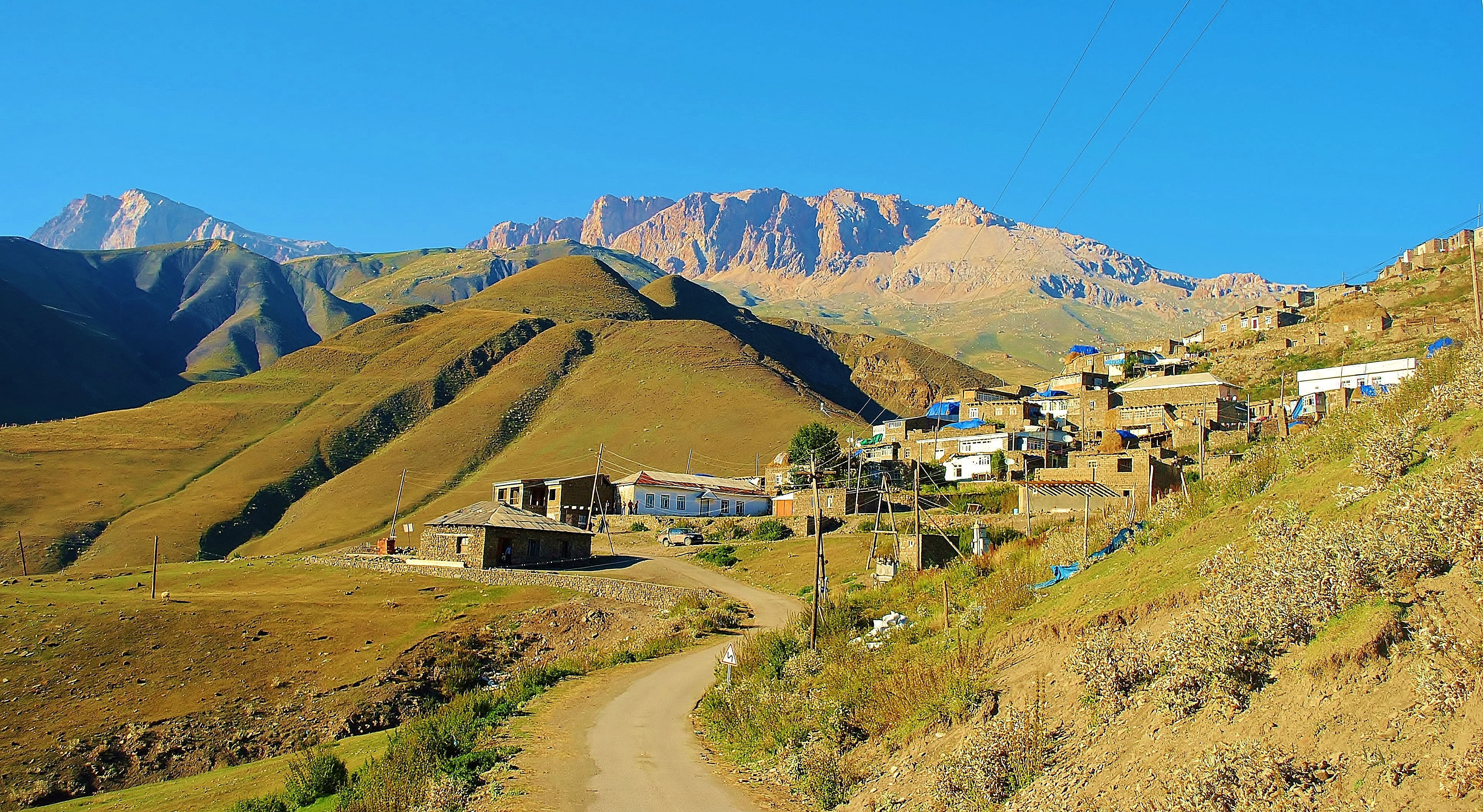
Azerbaijan – hill station Xinaliq which lies at the altitude of 2350 above the sea level.
My favourite place was a remote hill station of Xinaliq founded 5000 years ago, which at the same time is the highest altitude village in Azerbaijan and “the pearl of the Caucasus”. People living in Khinalug speak their own “khinalug” language although they also speak Azeri and Russian. Xinaliq village is beautiful and its extensive grounds give opportunity for stunning views of the Caucasus. The village is built of stones in such a way that it seems that one house is built on another. I went the local museum but the greatest pleasure gave me a walk through the narrow alleys of the village at all levels. I saw people with their daily activities, such as shoeing a horse, feeding ducks and a donkey transport. In the evening, despite the cold and dark night Xinaliq was still very much alive.
The only problem there was with getting there because the transport hub to Xinalix is a small town of Cuba, located about 40km away. The only solution was a shared taxi although the return was much easier because the locals travel to Kuba to shop and it is possible to go back with them for a small fee. Kuba is a small, gray city of unemployed taxi drivers and a street bazaar with holes in the road. I had a very interesting conversation there with one grandpa bearing medals on his chest who was proud of the Soviet Union. Well…
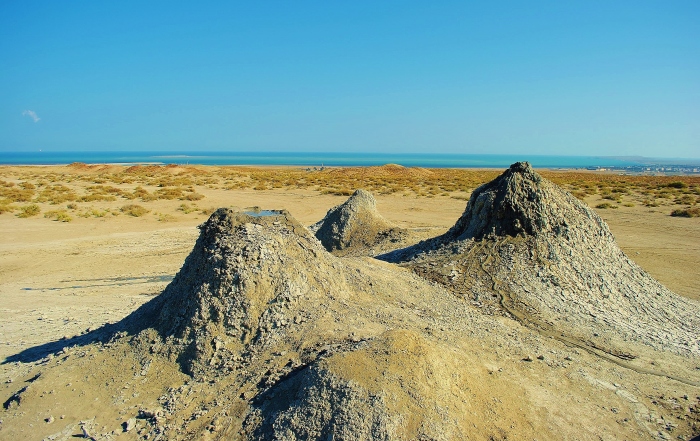
Azerbaijan; around Qobustan – mud volcanoes and the Caspian Sea in the background.
The people of Azerbaijan are helpful and curious of tourists although there were also surprised by my presence because tourism there is limited. I can’t say a single bad word about them. On the other hand Azerbaijanis prefer not to talk too much and didn’t trust me in the conversation because “they didn’t know who I was and for whom I worked.” They also didn’t react very well when they saw my camera because they were raised in the company of the KGB what brings bad memories. As a rule they prefer to not to touch the subject of the conflict with the hated Armenia because they don’t want to get upset. Sometimes however it happens that they open. According to Azerbaijanis taking over Karabakh and sending their army to Yerevan would be very easy but Russia would not allow them to do that. As for the cult of the late President Heydar Aliyev Azeris prefer to not to talk about it, even though they made me understand a few times that after all they didn’t have any reason to like him.
Armenia
Then I went back to Georgia just so I could immediately go to Armenia. Let me just remind that Azerbaijan and Armenia are at war and all connections and all border crossings between the two countries are closed. For that reason it is necessary to always transit through Georgia.
Armenia was more beautiful than I could even expect. I was delighted by the mountains and magnificent churches built many centuries ago and I definitely recommend Armenia to every adventure traveller. Whilst in Yerevan I felt sometimes like on a catwalk because there were so many beautiful women around, what is also very good about the country. I was travelling around Armenia for about 2,5 weeks, trying good food, enjoying hospitality of the people and sometimes listening to their stories of bad Azerbaijan. Once again, Armenia was a wonderful adventure during which I was usually crossing mountains on the way to ancient churches. Armenia is a very underappreciated but in my point of view a very attractive country to tourists. The same as Georgia, Armenia is also covered by mountains with many ancient churches. My trip around Armenia was a hitchhiking experience which I praised for many reasons. Even though Armenia is a country of beautiful mountains and a few attractive caves and canyons, it is the Christian monasteries which are usually the prime destination of all expeditions. Also noteworthy are chaczkars, carved in the stones Armenian crosses.
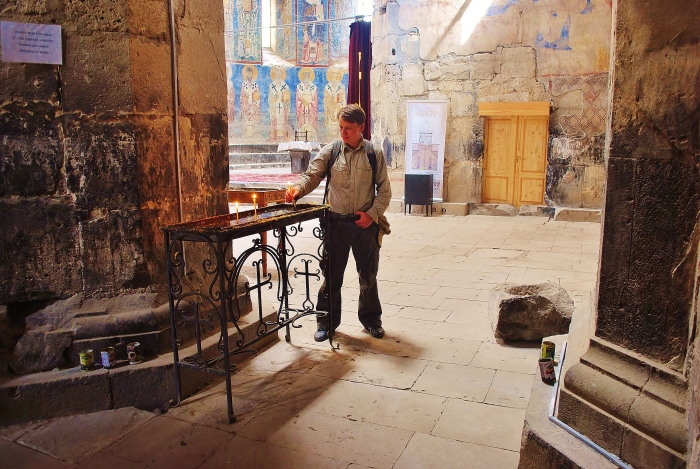
Armenia – in the ancient Akhtala monastery.
I started my trip around Armenian from the mining town of Alaverdi in the Debed canyon. Alaverdi is picturesquely situated in the mountains and the river and offers good food, nice views and even a cable car to the top. In Alaverdi however it is worth to stay because it is a base for many attractive, ancient churches in the mountains and during my trip I hitchhiked to all of them. The first one was the X century Armenian Sanahin monastery. It was a very atmospheric building of thick carved walls and pillars and the roof was covered with moss. Within the Sanahin area there were also quite a few khachkars – carved crosses in rectangular rocks. Another beautiful church was Haghpat started in the X century and finished in the XII century when a beautiful tower was built, a library and a charming chapel. All the facilities were built of stone and had hachkars carved on the walls and on the rocks. Besides, various chapels and churches stand on different levels and are of different heights and also partly covered with green hills. When I was here Haghpat was engulfed by fog which gave an even a better effect.
Later I went to Odzun plateau to a small town of the same name with post-communist blocks and some spectacular wrecks of trucks. In the quiet of the Debed Canyon there is also Odzun monastery which was begun in the sixth century and which expanded in the eighth century. In the Debed canyon there is also Akhtala, a beautifully situated XIII century monastery standing near the cliff. In addition, the entrance and the walls look like a fortress what means that it could be easily called a fortified monastery. Akhtala is made up of several buildings and is famous because of its sculptures and frescoes inside. The monastery has interesting stone arches, massive pillars, colourful altar and as I said earlier frescoes of depicting the saints.
After the Debed canyon I continued my journey but mostly by hitchhiking. First, I stopped on the road to climb to the top and see the ruins of the Kobayr church hidden among the trees, but that one was in a very bad condition. Kobayr monastery was built in the twelfth century and although it is still damaged we can admire the frescoes depicting Jesus, the 12 apostles and Georgian inscriptions. Hard reconstruction work takes place over there and below there is a wooden house where the hosts are happy to sell or give some grapes. Then I stopped the next car and after driving through a beautiful canyon I reached the Soviet city of Vanadzor, a sad and grey town made of concrete slabs. From there a guy who picked me up clearly had the most sober years of his life behind him and told me to not to fasten my seat belts because he “fucks the police”. Unfortunately, first we stopped at vulcanization garage and it took so long that out of boredom I helped at the adjacent construction site. I helped to break up concrete stairs with a large hammer by several pedestrians also tried.
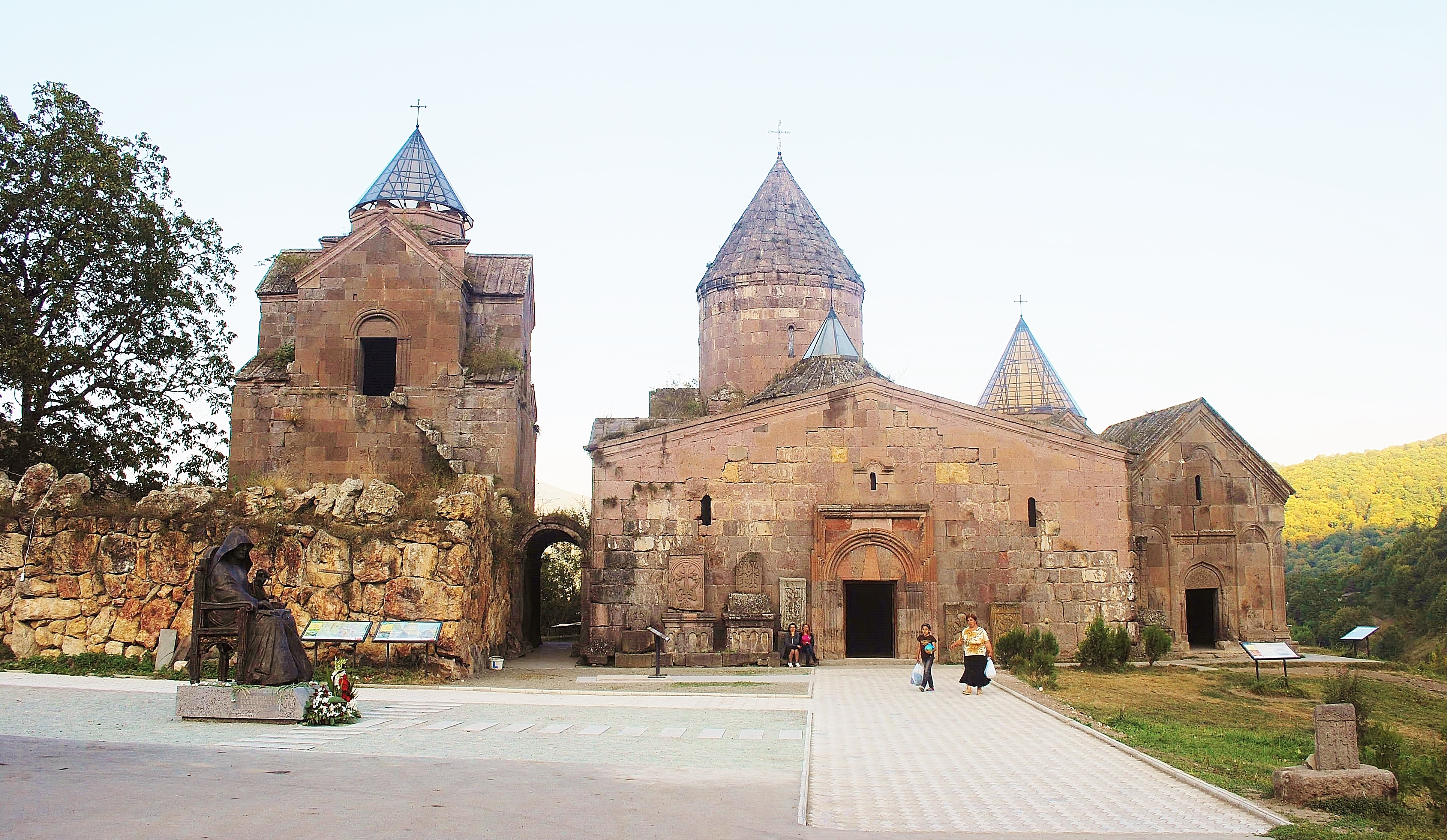
Armenia – Goshavank monastery.
After all I arrived to Dilijan. Dilijan is more fun because there is an interesting art gallery although on the other hand Dilijan is also sentenced to have a communist monument called “50 years of Soviet Armenia”. Whilst here, I went to Goshavank, a church built in 1188 which lies on a hill near the Gosh village. It is another beautiful Christian building of Armenia built entirely of stone. The whole area consists of a main church, two smaller ones, a school and a library. Inside there are massive pillars, nice altar, candles to light, deaf silence and an effect of sunlight coming through a small stone window. Outside there are also a few khachkars (crosses carved in rectangular rocks). After Goshavank I went to Parz Lich, a small relaxing area for tourists. The beauty of Parz Lich is in its green lake surrounded by mountains and forests with its beautiful silence. Whole families go there to enjoy fishing and have a barbecue and it is a unique, pleasant and a peaceful place. From there I went to Hagartsin monastery built in the twelfth century which consists of two churches and a small chapel. That monastery, the same as the previous one was built of stone and it is situated in a picturesque valley under chestnut trees. Within the church there are also several beautiful khachkars, interesting stone arches and a carved likeness of Mary and Jesus above the entrance door.
On the way to Yerevan I stopped in a very nice place. Lake Sevan is the largest in Armenia and the Caucasus and is also one of the largest high-altitude freshwater lakes in the world. Due to its close location to Yerevan, it is a tourist resort in the summer season. There are also several hotels, restaurants and a few stalls with souvenirs. Outside the summer season lake Sevan attracts several fishermen catching trouts but most of all the place is visited because of the Sevanavank monastery. The monastery was originally built on an island but the level of water decreased and created a peninsula. Sevanavank was built in the ninth century, it is located on top of the mountain and consists of two churches: Arakelots and Surp Astvatsatsin. They are very similar to each other, built of stone and covered with red roofs.
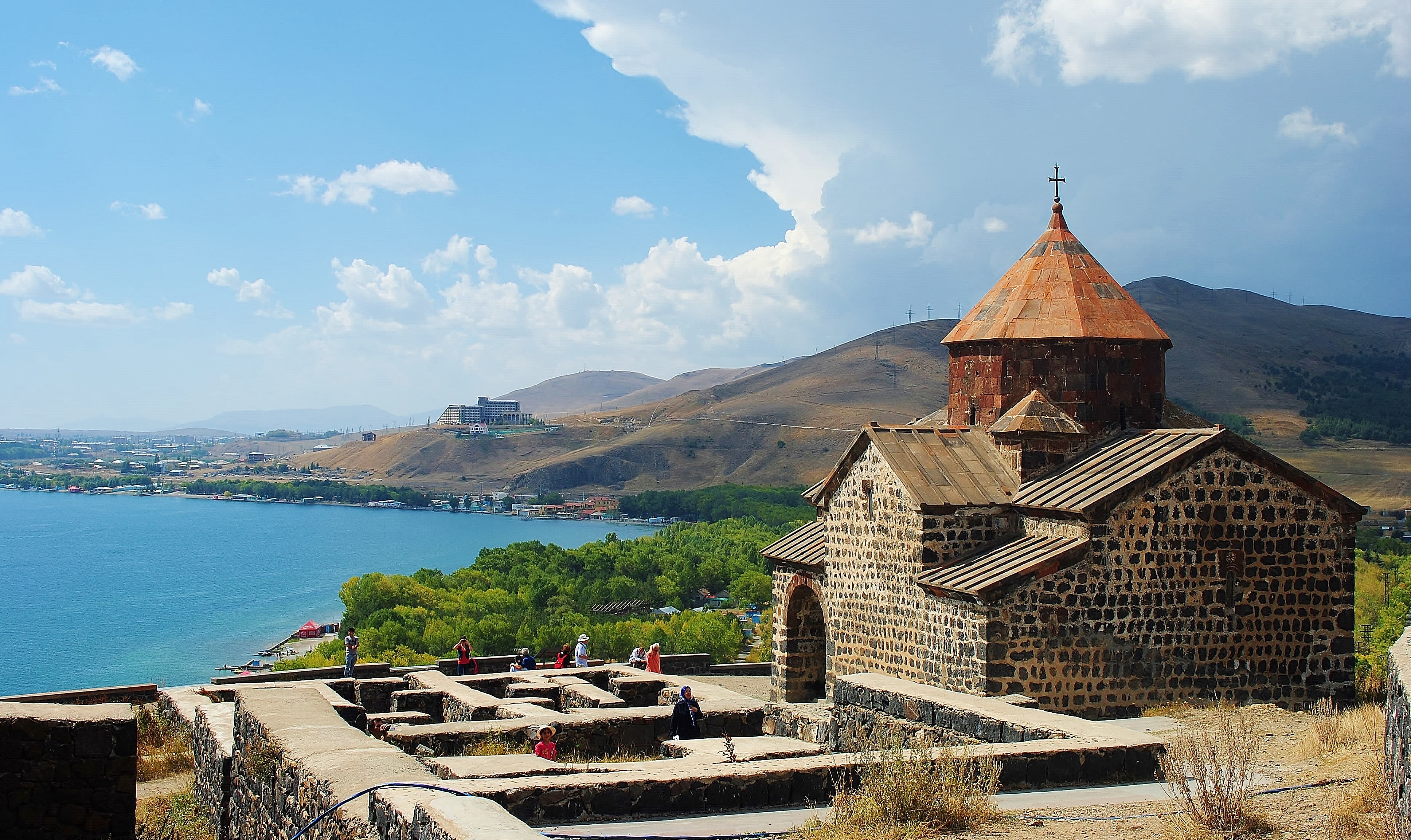
Armenia – Sevanavank monastery and Sevan lake in the background.
After Sevan lake I stopped another car and got to Yerevan. I lived by the opera, in the centre. Yerevan is the cultural, political and economic centre of Armenia, a city of beautiful architecture and interesting galleries and on the other hand also a the city traffic and busy life. Central Yerevan is around the opera where the cultural life spins around. Within a small distance there are parks, museums, numerous fountains, galleries in the open and the Cascade which is the most impressive building of all. Yerevan is also a city of beautiful women who walk around the city like in a catwalk and present their charms what only adds light to the city. Many times I sat in the museum part of the city watching the fountain moving to the music and I walked around the artificial ponds and walking among the sculptures to climb the cascade.
Near the Opera House which is the official centre there is a Cascade which I mentioned earlier. It is a high floor structure on which I climbed on high steps. Before the entrance there is a park where there are many interesting and also funny sculptures such as the statue of fat women and a fat cat and a monument to the fat Roman soldier. On each of the floors of the Cascade there are different types of fountains and different sculptures. One of them is a great head coming out of the water, diver in various phases of flight, a man with a ghastly smile and my favourite – a lion made of tires. I also went to the National Gallery and the National Museum but I was not alone. I met a nice Polish woman with whom I saw the whole display and that because I wanted to save money on the museum entrance I used my diving card instead of a student card. The cashier didn’t speak English anyway so it was fine. What impressed me the most was the art gallery and especially the paintings of Western and Russian painters with and some lovely sculptures. The National Museum tells the story of Armenia since the Greek times to the transition to Christianity and then the invasions of Turks, Persians and Arabs (always Muslims!).
I spent three days in Yerevan and saw a lot of interesting places such as the Brandy Factory, Erebuni Fortress or the Blue Mosque which symbolises good relations with Iran. However the most unforgettable memories I have from the Monument and the Museum of Armenian Genocide (Tsitsernakaberd). It is a moving, tragic place telling about the crimes which Turks committed against Armenians and which is also an irrefutable proof of what Muslims are capable when it comes to final solution for Christians. (I described in more detail below).
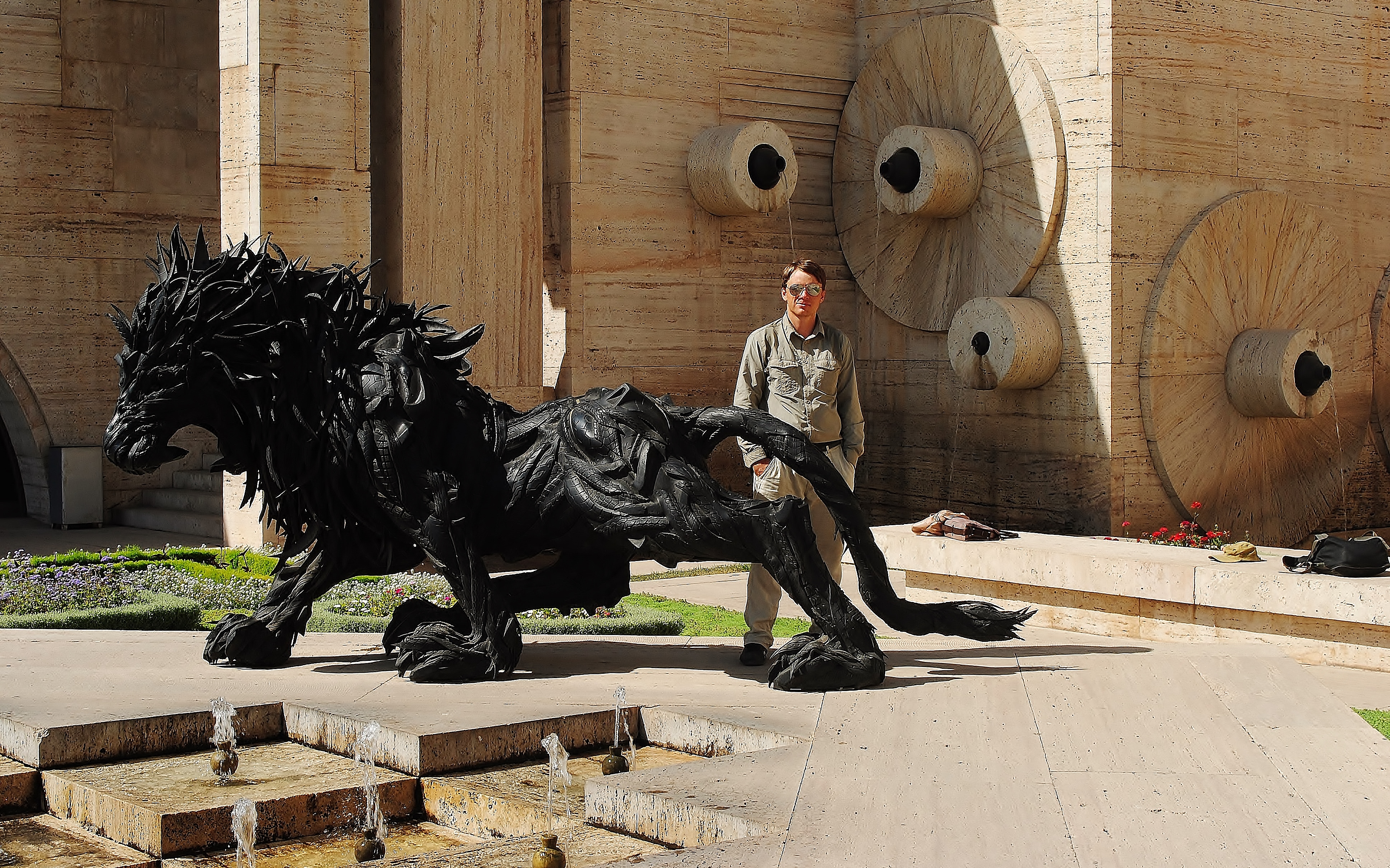
Armenia; Yerevan – on the Cascade next to the lion figure made of tiers.
From Yerevan I made a few trips. First I went to Eshmiadzin which is one of the biggest Christian attractions of the country and is also sometimes called the “Vatican of Armenia”, although in my opinion and many other travellers as it is a big exaggeration. Anyway, there are many interesting churches and cathedrals in Eshmiadzin which are the UNESCO world cultural heritage, it is a seat of the Armenian Church and was also the capital of Armenia in the years 180 to 340. One of the temples is a very proud sounding The Palace of Catholics, although the main church is Mayr Takhar which is one of the oldest churches in the world since it was built around 301-303 when Armenia converted to Christianity. Outside of the temple complex of Eshmiadzin there are three beautiful churches worth mentioning. The first one is the Shoghakat Church built in 1694. It is not big because it has one main bell and a small tower built of red stone and it is surrounded by a nice garden. Another church is the Cathedral of the Blessed Mother of God built in 1767 which today is the seat of the Diocese of the Armenian Apostolic Church. The last and also beautiful is Church of the Holy Hripsime built in 1618. This church is one of my favourite ones because there was hardly anything changed and its beautiful, classic lines inspired many other Armenian churches.
The next churches are Geghard and Garni, which are one of the greatest attractions of Armenia and are situated in beautiful natural surroundings. The two main churches of the Geghard complex and two chapels were built in the 13th century. The chapels are carved out of the rocks and inside there are prayer candles and sculptures of, among others, eagles and lions. In one of the chapels there is also a spring with water, which according to beliefs has the properties of preservation of youth. My feeling about Geghard is very good. It is a complex of Christian caves and churches, and the atmosphere over there I describe as dark, mysterious and cold. I think that Geghard is a very atmospheric object, and my favorite part were the dark caves with candles inside and churches with their massive pillars, carved windows and arches. Besides, Geghard is built on several levels, what means that after climbing the stone steps one can see churches, people and the canyon from many heights.
The second monastery, only 9 km from Geghard, is the pagan temple of Garni, and it is unique because it is completely different from all the others. Garni was built in the 1st century by the King of Armenia Trdata I, for Helios, the Roman sun god. This temple looks like the Greek Acropolis and the views from it extend to the great, picturesque canyon.

Armenia – Garni temple.
From Yerevan I also went to the biblical Khor Virap, which is another wonderful monastery built on a rock. It lies in the background of the Ararat peak, where Noah’s Ark got stuck after a 40-day cruise. Khor Virap is also the temple which is very often visible on postcards, although I admit that in order to see the monastery against the background of snow-covered Ararat, you need to have perfect weather in the high parts of the mountains; what happens very rarely. The construction of the foundations of Khor Virap began around the 5th century, but the entire complex was completed in the 17th century. The main object here is the Church of the Holy Mother of God (St. Astvatzatzin), which is not big. It has only one small bell and a tower, it is red and has rich decorations inside. In addition, I also recommend a dark chapel where you can light candles.
From Kor Virap I didn’t return to Yerevan, but headed towards Iran. I waited for some time on the road with my large backpack, and after about half an hour I finally hailed down a 35-year-old Ziguli, with rust carefully covered with paint. I was traveling with an Armenian family and after a few hours of interesting driving, the driver dropped me off on the side road to the Noravank monastery, at the Areni cave. The Areni Cave, in addition to its geological wealth, was also interesting in terms of discoveries related to people. Archaeologists believe that as early as 3900 BCE people lived there and had the world’s first winery. While walking around the cave, I saw illuminated tunnels, broken jars and other everyday items that were in the cleaning phase. I spent that night in a tent on solid ground, and it was not pleasant, but as far as I can remember I was able to close my eyes for a few hours. I woke up around 7 am because I was cold, and I went along the river to a parking lot for trucks. There, women made me breakfast for little money and I also got tea as a gift.
Then I went back to set up my tent and went along the Areni canyon towards the Noravank monastery. Noravank was built in the 13th century and is a well-known in Armenia because of its picturesque location in the middle of a canyon on the Darichay River. The Noravank Monastery offers beautiful views of the red cliffs of the mountains, and is one of the few two-story temples. The main object is the church of S. Astvatsatsin, decorated with beautiful bas-reliefs, one of which depicts God the Father.
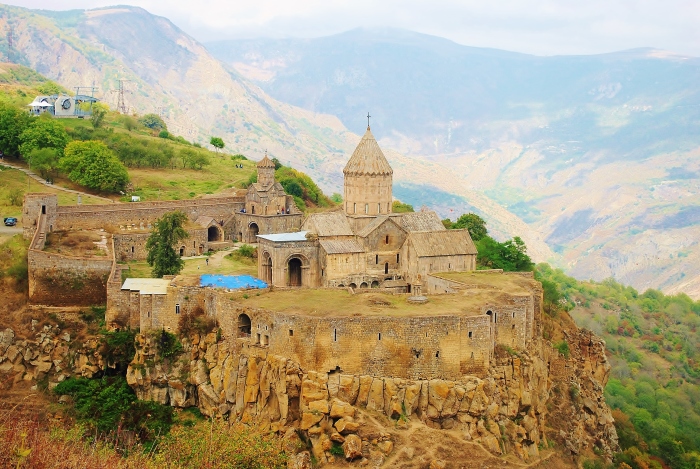
Armenia – the fortified church of Tatev.
I also recommend Vayots Dzor which is one of my favourite parts of Armenia. Over there travellers can see the country life, they can eat nuts, pomegranates and grapes straight from trees. I stayed in Artabyunk where from I went for a mountain expedition. On the way to the Nagorno Karabakh I also stayed in the town of Goris where I saw houses built inside rocks, similar to those in Cappadocia. About 30km from Goris there is also a fortified monastery of Tatev which sits on the edge of a cliff and which is one of the top landmarks of Armenia.
To a tourist Armenia is a country of beautiful nature and beautiful churches set in picturesque landscapes. Food is good and healthy and people are nice and helpful. Armenia turned out to be one of my favourite countries and that’s why I warmly recommend it. I spent about 3 weeks in Armenia, sometimes sleeping in a tent and sometimes just under the sky. I travelled mostly by hitchhiking what let me have a very good contact with people.
Nagorno – Karabakh
At the end of my Caucasian adventure I went to the Nagorno-Karabakh Republic which is a very small and interesting country that formally does not even exist. Nagorno-Karabakh is a region which declared its independence and it is independent only in its own eyes and no one else’s. In addition Nagorno-Karabakh has its capital city called Stepanakert which is in reality just a main town and it also has a heavily exaggerated persons such as the president and the prime minister, despite the fact that the government of Armenia has the final word over Karabakh anyway. Officially Nagorno-Karabakh still belongs to the territory of Azerbaijan but it is occupied by Armenia. In 1920 Stalin proclaimed Nagorno-Karabakh as the autonomous region within Azerbaijan but in later years Karabakh asked for its independence by force with the help of Armenia and it has kept it to some extent since then. On the other hand due to the uniqueness of this small area and despite the fact that this self-proclaimed region keeps pretending a country I’ve decided to present Karabakh as a separate section on my website because I think that it is a travel story which should be told separately. Nagorno-Karabakh is also called “the Armenian culture within the territory of Azerbaijan”. What’s more interesting I even got a visa to a country which does not even exist.
Whilst in Karabakh I saw small towns destroyed by bombings carried out by Azerbaijan but also centuries-old churches, fortresses, mountain views and attractive nature. I spent five days in Upper Karabakh moving around mostly by hitchhiking what let me see a lot of interesting places. I noticed that the Karabakh people want tourists to visit their region so they could hear their story about the war with Azerbaijan and the struggle for their independence.
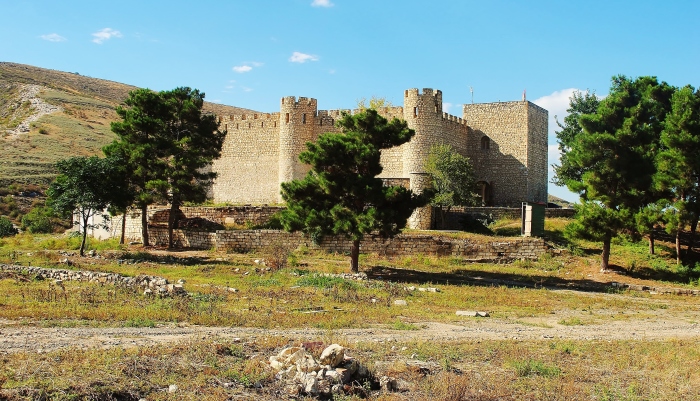
Nagorno Karabakh – the Mayraberd fortress.
Travelling around Nagorno-Karabakh is a hitchhiking adventure through far away mountain serpentines where at every stop awaits a good story. I stayed in the capital city of Stepanakert which is a very pleasant small town and where among many things I saw the museum of war with Azerbaijan, the museum of killed and missing soldiers and also the part dedicated to the Soviet propaganda in order to praise the Soviet Union as the conqueror of Hitler. The first museums were interesting and it is a topic that never ends because about the war with Azerbaijan would gladly tell us a truck driver, a meat salesman and a priest. The war subject in Karabakh simply does exist. I was under impression that the subject of glorification the Soviet Union is present in Karabakh but “without the ceremonial openings of champagne” and it is there as if someone was watching over it through the keyhole. I’m not going to defend Hitler but Stalin’s hands were just as dirty. The difference lies in the fact that the winner does not have to explain his crimes and a loser apologizes and pays for a very long time, even for the sins of others. Whilst in Stepanakert I saw a traditional bazaar, a tank on the pedestal and the statue that has become a symbol of Karabakh which is called Grandpa and Grandma.
I also liked the ruins of the town of Shushi situated 9km from Stepanakert. The town lies mostly in ruins after the bombings carried out by Azerbaijan but it comes to life and I think everyone should see it. I would also recommend a very interesting art gallery and the white Ghazenchetsots Cathedral, though I was mostly interested in the people living there and the ruins.
I also found the town of Agdam very interesting because it looked like a haunted place. After heavy bombardments carried out by Azerbaijan only a few houses remained and those that still stand are in terrible condition as they always miss walls or roofs. Agdam is on the line of fire with Azerbaijan and before the “town” I saw a military base of Armenia with a few big cannons and armoured vehicle. My feelings about Agdam are obviously tragic because about 20 years ago it was a normal city. People lived there, they went to work and children went to school. Today it is hard to imagine that there was a life there because today there are just ruins with a few standing walls. Either way Agdam was very special war experience which I highly recommend.
Apart from that Karabakh has a couple of interesting fortresses, such as the very attractive Mayraberd ruins and restored Tigranakert fortress. For such a small country Karabakh also has beautiful, ancient churches built in Armenian style, for example Gandzasar and Dadivank built in the fifth century. The Kharabak’s phenomenon of nature is the exceptional 2000 year old Skhtorashen tree which is empty inside and so huge that it could be converted into a studio flat. Besides, Karabakh is of course about hitchhiking trucks, stories about the war told by almost sober drivers, post-Soviet markets and the unforgettable atmosphere of the whole place.
I recommend my full report and I also recommend a tour around Karabakh where sooner or later you will find transportation.
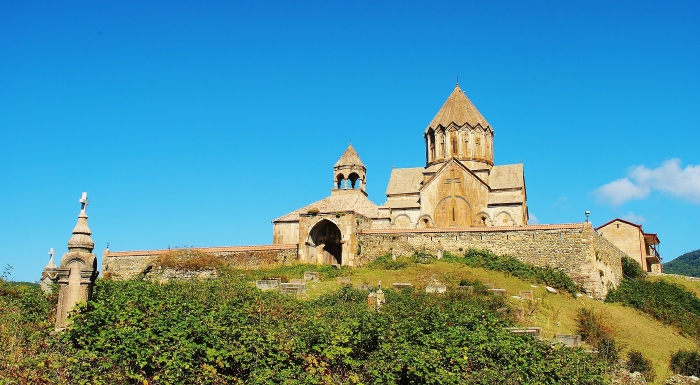
Nagorno Karabach – Gandzasar church.
Summary of the Caucasus
My expedition around the countries of the Caucasus let me not only see a new region of Asia (located on the border of Europe) but also let me learn about the history, interesting people and beautiful nature. Besides that I learned Russian even better than when I travelled around Central Asia in 2010. Caucasus is a small region but in many ways it is very rich and it requires exact exploration. To tourists Caucasus is a great adventure and if only Azerbaijan gave up the visas or at least stopped giving bureaucratic headaches, then every expedition around that country would be also more enjoyable. In addition to the above my expedition around Armenia, Georgia and the Nagorno-Karabakh made my already strong Christian spirit even stronger. I definitely recommend the Caucasus.
————— ♦ —————
Iran
After the Caucasus I began my journey around Iran which proved to be so interesting and full of so many adventures that I stayed there 1 month and 10 days. Because of the hate propaganda Iran is a very unpopular country. All we hear about Iran in our media is the nuclear program, alleged terrorism and religious fanaticism but after 1.5 month of travelling I realized that Iran is a big, educational adventure. I entered Iran from Armenia and then I was moving south stopping in the most interesting places and finishing in the Persian Gulf. Let’s not expect that Iran of the 21st century will be a land from the Stories of One Thousand and One Nights but because I had enough time for my trip I realized that ancient Persia is still visible in Iran. Iran has a lot of tourist attractions and from my own experience I divide them into: sights, art, natural beauty, gardens, traditional Persian food and good people. If I had to describe Iran in a few words I would say: mosques, bazaars, kebabs, carpets and good people.
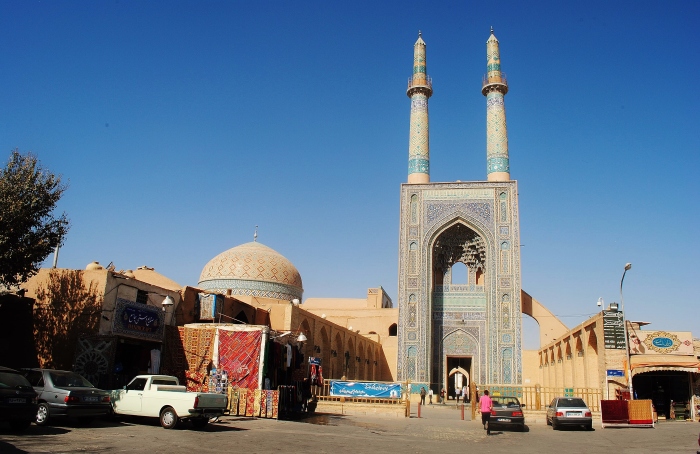
Iran – Khomeini mosque in Yazd.
I crossed the border with Iran in Norduz. I gave my passport to a very detailed check, I answered a few questions including whether I was in Israel or not and after about 20 minutes I was in Iran. My first night I spent in Jolfa, a small town near the Azeri enclave of Naxcivan. Then I went to Tabriz which is the fifth most populous city of Iran and the historical capital of Azerbaijan. The most interesting in my opinion was the Museum of Azerbaijan where there were a lot of interesting sculptures. I was also in the Blue Mosque, built in 1465, which is no longer blue because the tiles had already fallen off. I had an interesting meeting with young Iranians who complained about Islam. They told me that they had enough of the Islamic regime and they asked me to not to believe in the hate propaganda against Iran. In addition, the mosque is popular because young couples go here to cuddle away from the religious police. As usual in Iran bazaars where everywhere and the one in Tabriz was very impressive, probably because it was my first. There is also an Anglican church in Tabriz which I recommend.
On the way from Tabriz to Jolfa I stayed in a well-preserved Armenian monastery of St. Stephen from the ninth century, which I think is an important stop for Christians.
From Tabriz I went to Kandovan which is a village carved in rocks resembling ice-cream wafers and which boasted the traditional life of the people. In Kandovan I saw people dressed in traditional costumes, a donkey cart and souvenirs manufactured on site such as pottery and carpets of camel fur. The town is the equivalent of Turkish Cappadocia or Armenian Goris because in both those towns there are spiky rocks turned into rooms. Then I went to Rasht where I changed the money, I drove through a small town called Fuman and I finally got to Masuleh, a town that should be never missed. Masuleh is a very popular mountain village for tourists which is at least 1000 years old. Clay houses are built on one another and are compressed in such a way that a roof of one house is the transition to another or to an observation deck. The streets are so narrow that with such great numbers of tourists they can barely move. I walked up and down many times and each time and every time I concentrated on a different thing and people of Masuleh watched me. A lot of them wanted to talk to me about Europe and relations with America but somehow nobody wanted to talk about Israel as the word itself made Iranians throw up.

Iran – Kandovan.
My next destination was the city of Qazvin where I spent a few days but longer than I expected because I had a problem with the visa. I wasted a whole day sorting it out until I finally developed a new new at a police station. For the first time I also had to deal with the Iranian bureaucracy and negligence of the police officer who made a mistake when filling my passport. Anyway, I saw several mosques with large squares and the interesting Museum of Calligraphy. For the first time I also experienced the Iranian regime. When I was taking photos police told me to delete some of them and then when young women wanted to help me find the right way they quickly ran away from me when they saw that the police were watching them. Qazvin was a pleasant city with good food but tourists mostly stop there because it is the base for the Castles of Assassins and the Alamut Valley, where I fired a whole day trip. I was driving through rice fields, palm trees and a desert, I stopped by in a few small villages and I finally climbed to the ruins. Due to its remote beauty, superb scenery and ancient castles the Alamut Valley is the most popular excursion from Qazvin. The Alamut Valley is the area between Qazvin and the Caspian Sea in the middle of the Alborz mountains. In the eleventh century the leader of one sect of Islam called Ismaili Hassan Sabbah converted the local people to his version of Islam and founded the brave and blood chilling Hashshashin tribe (tribe of Assassins). Together with his people they built several castles which are impressive due to its location in high and inaccessible parts of the mountains.
In the end I came to Tehran, to the great capital of the Islamic Republic of Iran, which was my base for several weeks. There are a lot of Iranian opinions about the Iranian capital. The most common is that Tehran is loud, crowded, chaotic, crowded and full of traffic which gives a headache. Some tourists don’t go to Tehran and others drop in just for one day and come back again because they are not able to take it. In a city that is a home to 15 million people a lot goes on but luckily Tehran has a very well developed underground network without which transport in a Tehran traffic would be impossible. Among the many interesting places first I saw Azadi Square and Azadi tower. The tower is shaped in an inverted “Y” and has a sophisticated modern design combined with traditional Persian culture, has a gallery in the basement and a lift that can take us to the top floor. Iranian media love showing Azadi tower to the West during revolutions and political news. When the Iranian nation is unhappy and wants to destroy the city Azadi Square is always full.
After a short rest first I went to the traditional bazaar where I later returned many times. This chaotic and crowded bazaar is a city within a city and it also attracts those who are not interested in shopping. Bazaars are an important part of the Persian culture and they are not just commercial centres but also places of social, political, cultural and religious importance. Shops decorated with silk, carpets, traditional sweets and spices attract traveller’s attention but there are also exchange offices, shoe cleaners, tailors and manufacturers of cigarettes, copper pots, knives and even saddles. Furthermore every bazaar has tea rooms where I spent nice time with Persians and answered a lot of questions, because in Iran everyone was very curious why a Polish traveller wanted to visit their country. Whilst having tea, next to a small fountain, just behind a chamber with handmade carpets and with a packet of dates in my hand I had a very good time. Generally, every city in Iran has its own bazaar but the ones I recommend are in: Esfahan, Tehran, Tabriz, Shiraz, Yazd and Kashan. Apart from that I saw a Khomeini mosque, an interesting Golestan Palace and Park-e Shar.
I also went to the National Museum of Iran to see the archaeological and well presented history of Iran. The museum houses mainly exhibitions of Persepolis and findings from Shush in the form of statues, pillars, pottery and a lot of sculptures. However, the two places which I will always remember the best are Ebrat Museum which is a museum of the Shah’s torture and the former American embassy with graffiti depicting America in its true light. In the south of Tehran, I was also in a great temple complex called the Mausoleum of Ayatollah Khomeini which has been turned into another monument of money in the name of the Islamic propaganda. I liked the north a lot more. I went to Tajrish to walk in the mountains but I also went to a couple of museums and I saw another mosque because it was impossible to not to notice it. When in Tehran I also do recommend going to the Carpet Museum.

Iran; Tehran – the Azadi Tower.
I left my things in Tehran many times and went for trips. Once I went to climb Damavand and another time I went to the city of Hamedan where from I reached the water cave of Ali Sadr. I think it is important for everyone to go to those two places and see that there are things in Iran which are not related to Islam. Then I returned to Tehran but only to quickly go to Qom which is the second holiest city in Iran. Qom is one of the most conservative cities in Iran and the pilgrimage place for Muslims to the temple complex of Hazrat-e Masumeh. Women are covered in black sheets (chador) and Muslims from many parts of Iran and Arab countries come to schools of Shi’ite Islam. Muslim clerics began their revolution against the Shah from Qom and Ayatollah Khomeini and lived there too before he was exiled to France.
Whilst travelling around Iran tourist must see the 4 major cities, such as Kashan, Isfahan, Shiraz and Yazd. All of those cities are the show of ancient Iranian architecture and I’m not talking only about the mosques. Kashan is one of the oldest cities in Iran with rich history and many interesting sites. Despite constant wars fought for centuries by such devils as Turks and Arabs and despite an earthquake in 1779 Kashan has survived to this day together with many wonderful objects. In addition to the large traditional bazaar and several mosques the main showcase of Kashan are the merchants’ houses which are great architectural wonders of ancient Persia. Kashan can be also proud of its traditional baths and caravanserai, out of which one is converted into a hotel and at the entrance to the city there is also the traditional Persian garden – Fin. The old part of Kashan looks as if it was made from the desert and this is the part which can be still called the beautiful Persia, not the Islamic Republic.
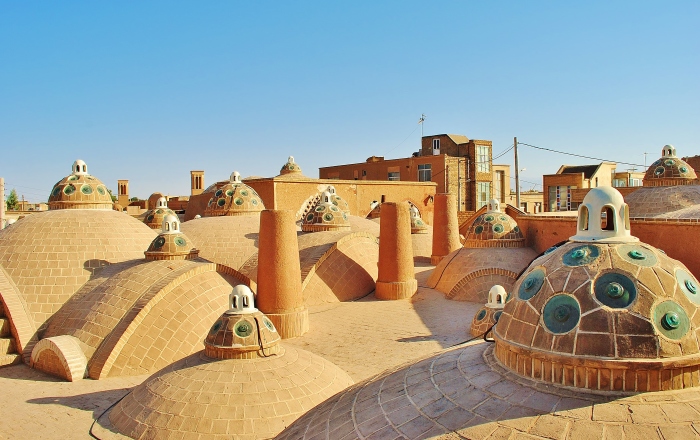
Iran – rooftop of a bathouse in Kashan.
After leaving Kashan I stayed in Abyaneh which is one of the oldest villages in Iran (above I wrote about villages of Masuleh and Kandovan) as it is about 1500 years old. It lies at the foot of Mt Karkas (3899m above the sea-level) and it was built of bricks made of red mud and towards east, to get more sun in summer and less cold and freezing winds in winter. Abyaneh is very special and it is sometimes called a red village. Its narrow streets lead through two-storey red houses, sometimes with wooden balconies. Due to its age and delicate design Abyaneh has been classified as the cultural heritage of Iran. When I left Abyaneh I almost immediately got a hitch by an old piece of rusty junk which took me up to the main road and then I stopped a truck going towards Esfahan. The driver dropped me off on the outskirts of Natanz, close to the famous uranium enrichment centre. (By the way I thought it would be funny if a Jewish American dressed in a CIA t-shirt knocked the police station door in Natanz and asked if they sell entry tickets to the power station). I noticed that the truck driver wanted to get rid of me, even though he was going to Esfahan too. Before we got to Natanz he was in a good mood but the closer we were getting to that place he behaved more and more nervous.
The old city of Esfahan is an architectural jewel of the Muslim world and the diamond of Persia. Esfahan has a great traditional bazaar full of interesting art shops with hand-woven Persian rugs, ancient gardens and bridges, fountains and blue domes and its great mosques. Old Esfahan is a wonderful way of going back to the times of ancient Persia and that’s why I advise travellers to dedicate enough time to that unique place. Travellers need time to walk around the old bazaars, to drink tea at beautifully painted ceilings and to accept invitation for another tea in a traditional carpet shop. A traveller would feel very well in Esfahan when walking around the Persian gardens or when sitting by the fountain in the Khomeini square, around greenery and horse-drawn carts. The carpet sellers and those who sell traditional paintings on animals bones will always have “a great deal only today and only for you.” Also, we should not miss the historic bridges and churches in the Armenian district and a few Persian restaurants. What ancient Rome or the Vatican or Athens are for an educated European, Esfahan, Yazd and Shiraz are to Iranians.
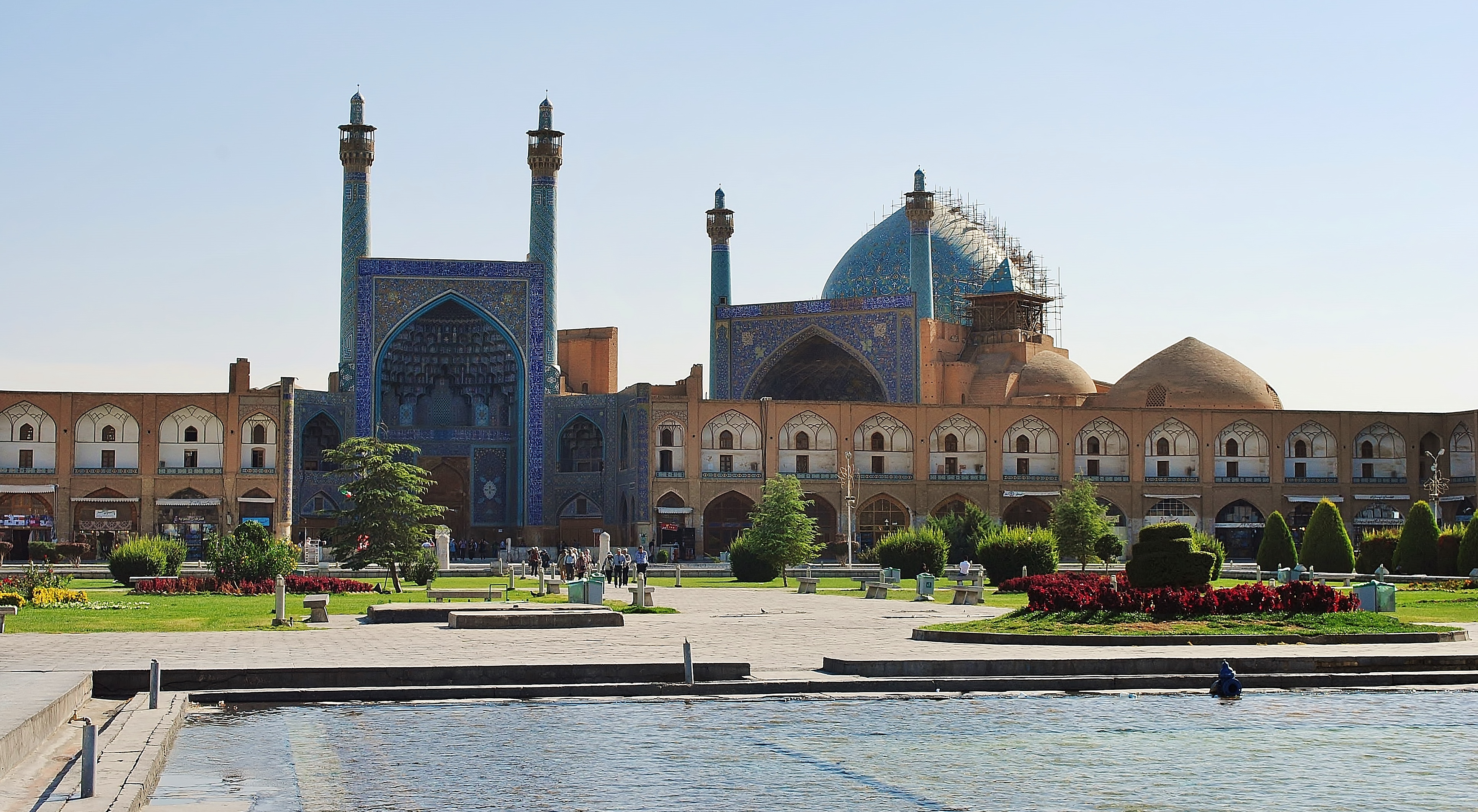
Iran; Esfahan – a mosque in Khomeini Square.
The desert city of Yazd is in my opinion one of the most beautiful cities in the whole of Iran and an architecturally very unique place. Lying 270km southeast of Esfahan, old Yazd gives the impression as if it was made from the desert. Yazd is also popular because of its beautiful souvenirs, handmade Persian carpets and candy. In Yazd there is also a large community of Zaroastrians – followers of the old religion of the ancient Persia who have interesting temple. In addition to the ancient sites, of which every one has its own history, Yazd has also good tea, beautiful Persian gardens, numerous decorations on the ceilings and the characteristic towers the “wind catchers”. Above all, the most special thing is that the old Yazd is almost entirely built of clay dried in the sun what means that the material used for its construction is the desert itself. The history of Yazd is about 3000 years old.
From Yazd I organised a one day trip to Chak Chak, Meybod and Kharanaq. I saw towns made of clay, a pigeon tower and a very interesting ice house which in a hot climate worked as a huge refrigerator without the use of electricity.
Shiraz is a very pleasant, 2,000 years old Persian city of many sights, beautiful gardens, ancient poets and production of wine Shiraz which is deeply rooted in the Persian culture. The object which dominates the Old Town of Shiraz is Arg-e Karim Khan popularly known as the ark. The Ark is a citadel built by Zand dynasty which once served as a prison, then as the seat of the governor and now it is in the hands of the Cultural Organization of Iran; and it has a very attractive garden. I found very interesting bazaar-e Vakil, a mosque of the same name and a public bath which was a work of art. Shiraz was once a great commercial centre and that’s why a traditional bazaar was in high demand. In the many attractive alley ways and shops to tourists, Persians sell decorated caskets, statues, figurines and Persian carpets of many sophisticated designs. There was even the Last Supper which I had seen many times before in Iran. Women can also find clothes and delicious spices so they could culinary pamper their husbands. I visited the bazaar many times to enjoy the atmosphere and to see the art.
In Shiraz there are also beautiful gardens with museums, with ancient architecture and with shade giving plants. I especially recommend Bagh-e Naranjestan. Another place which I also have to mention in this brief summary is Aramgah-e Hafez chapel built in honour of the Persian poet and the national hero and which is set in a romantic garden. The Hafez’s grave is under a stylish dome mounted on eight pillars and is in the centre of the garden. It is decorated with verses of his poems, it is illuminated after dark and carpet are rolled out during reading the Hafez’s poetry. Another place is Darvazeh-e Quran, what means the Koran Gate. It is a huge gate which symbolises the entrance to Shiraz and which was built in 1949. It is also worth mentioning that the canyon where the gate stands is called Allah Akbar because according to the local custom people who are at the top look at Shiraz and praise Allah. However, if someone wants to praise Jesus from there or send greetings to the Vatican it is also not a problem.
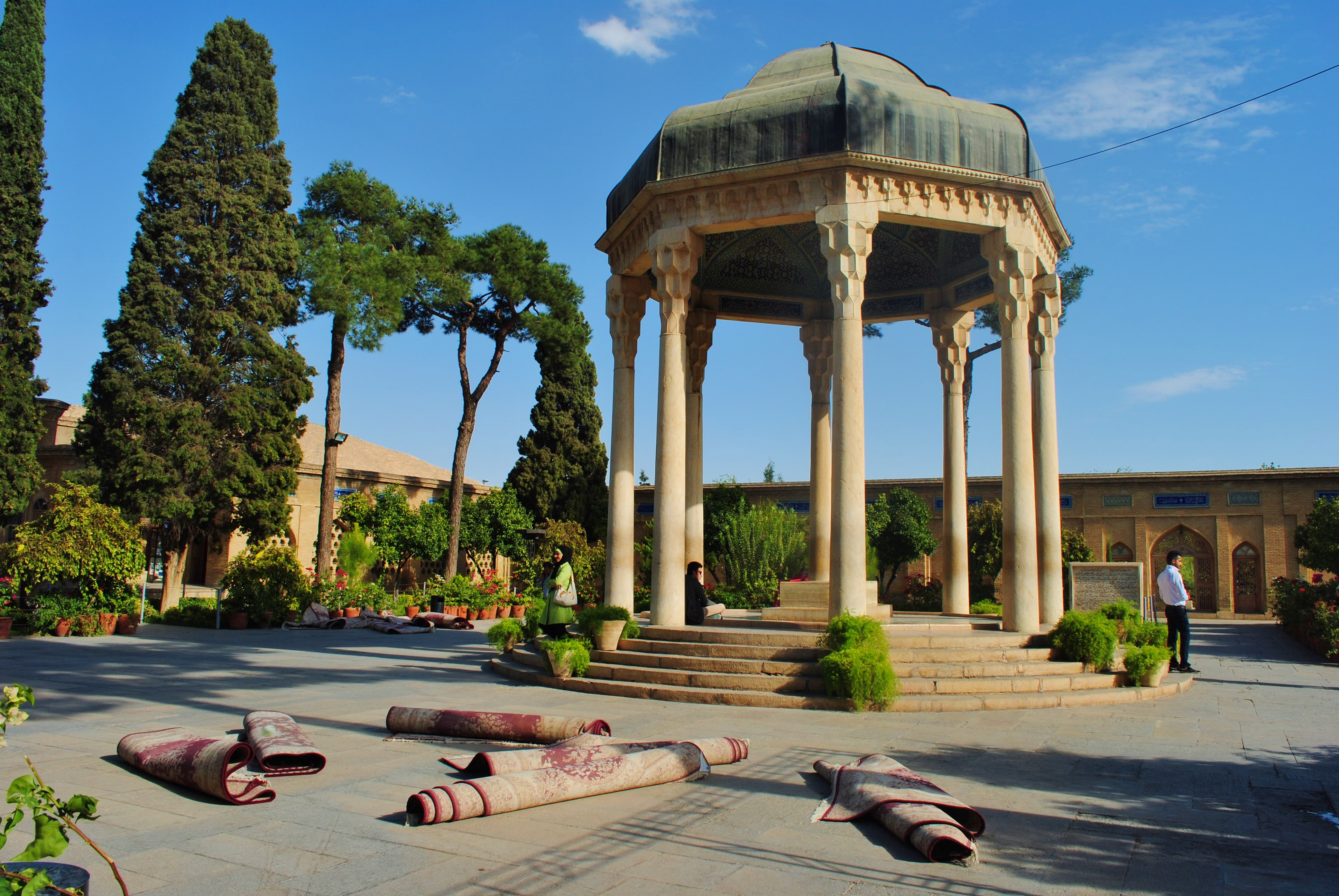
Iran; Shiraz – the chapel of Aramgah-e Hafez built in honour of the Persian poet and folk hero, set in the romantic garden.
From Shiraz organised a trip to Persepolis which is a must see for tourists. Persepolis was the capital of the Persian Empire which at its greatest splendour stretched from Greece to India. It was built by Darius I and his son Xerxes around 500 BC. This ancient city was once a home to the majestic king of all kings for about 200 years. At the time Persia was so powerful and yet overbearing and ignorant that in its manic glory none of the kings built up fortifications around the city because they were under opinion that it was the unconquerable and eternal empire. But everything has its beginning and the end. Persia made a big mistake to burn the Acropolis in Greece because shortly thereafter, in 333 B.C. Alexander the Great plundered, destroyed and set fire under the great and “eternal” city of Persepolis.
It must be remembered that Alexander did not rob the innocent ones, because in those days the Persian Empire was the biggest enemy of Europe. According to the historic data the Persian Empire stole so much that Alexander needed 20,000 mules and 5,000 camels to take away all valuables from Persepolis. Since that event Persian domination was replaced by Greek and Persepolis was left in ruins. Just to think that 2,500 years ago through the great Gate of Nations passed kings with gifts for the “king of the kings” but today the ruins of Persepolis are only a popular tourist destination among tourists from Europe and from Iran. We Europeans look at Persepolis with delight and for historical reasons we try to imagine the size and splendour of the former capital of the Persian Empire but Iranians go there to remember the time when their country was the most powerful one in the world. Beside, there are also Naqsh-e Rostam (Necropolis) and Naqsh-e Rajab which I visited on the same trip.
Bandar Abbas is a smuggler’s hole in the Persian Gulf which is less inspiring to tourists than the ridiculous “religion of peace”. Due to its location – which is due to the fact that through the Strait of Hormoz passes each barrel of oil in the world, the commonly known Bandar is a unique place. In addition to oil Bandar Abbas is the smuggling and trafficking capital, starting from Persian carpets, through weapons, drugs, cars, cosmetics, flat-panel TVs, motorbikes, sunglasses, drinks and a lot more. Police is paid to be blind and deaf and business is booming day and night. For this reason Bandar Abbas is the meeting point of suspicious element from all over the world and of course “no one has anything to do with it”. In addition to Persians there are also Arabs, Bandaris, the ever money hungry Indians and Negroes from Africa. In the eighteenth century in the smuggling and exploitation business dipped their equally dirty although looking clean white hands of the British, French, Dutch and Portuguese too. For centuries that strategic and a very “hot” place has become one of the major ports of Iran, the base of the Iranian Navy and the source of living for nearly 90,000 registered families and the towns’ suspicious component.
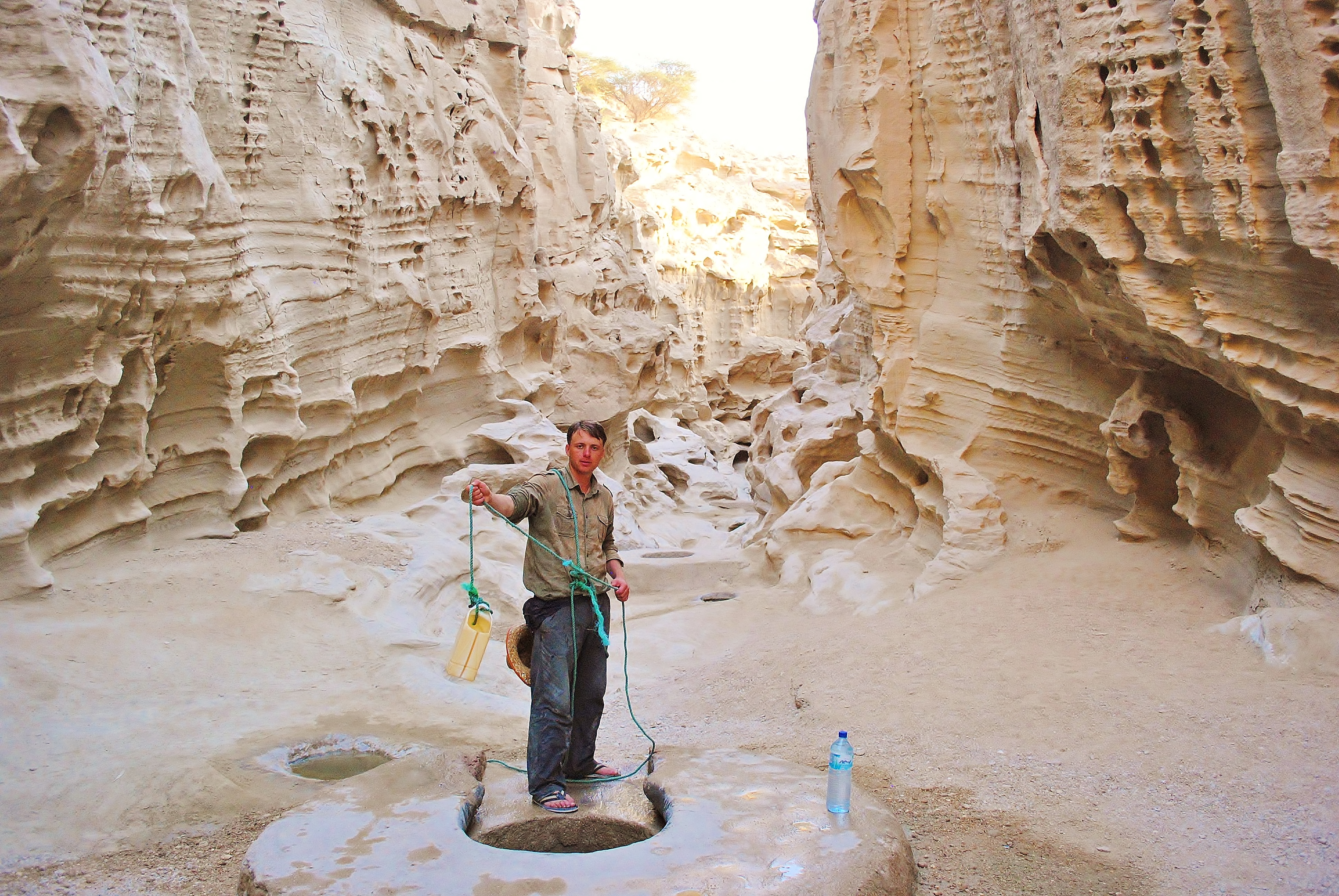
Iran; Qeshm Island in the Persian Gulf. After many days of desert expedition I reached the well. I was tired and poor but happy.
From Bandar Abbas I sailed to the island of Qeshm where I had a desert trip of my life. In a whole week I went through the sands of Persia, I was in the beautifully carved canyon, I was on a boat trip in mangrove forests, I saw the largest salt cave in the world, an Arab shipyard of wooden boats and wild camels. I moved around by hitchhiking and I only slept in a tent. I ate basic food, bathed in the sea and I got water from a well; and I have to admit that after a week of the desert heat and a lonely rough life I was in such a shape that I lost weight and it took me some time to recover. Then I also went to the island of Hormoz where I saw a Portuguese Fort, though it was a lot calmer over there. Although my experiences in the Persian Gulf were unforgettable I gave myself a really hard time.
Then I went to Kerman where there were also a couple of interesting things to see but I felt that the best of Iran I already had behind. In Kerman they had good sweets and good food but as it is in Iran also more bazaars, mosques and baths. Whilst there I also went to Kaluts, tall and huge sand formations in a desert. I spent the night in a desert in my tent and it was hard because the wind tore my tent apart and then it started to rain. Then, through the desert and the mountains I hitchhiked to Rayen and then to Bam to see the ancient fortresses made of clay. Especially Bam was really tragic as the citadel was destroyed by an earthquake on the 27 December 2003. Even 10 years before my trip to Iran Bam was known in the world because of the 2000 year old citadel consisting of high clay walls, 38 towers and a fairy tale castle within the walls of the ancient city, built in the Sassanid era. 2,500 years ago Bam was an important trade and cultural centre between Persia and the Indian Subcontinent and between the Persian Gulf and Europe. Marco Polo travelled through that part of the world and now I did, although I was unfortunately late because once the great proof of the rich history of the region and a diamond of Iranian tourism….now lies in ruins. (I also want to add that this route leads to Pakistan and that’s why it is a very hot smuggling area when it comes to weapons and drugs. It also made me think how it is that Iran has such a tight border with Pakistan and England does not).

Iran – Kaluts.
My Iranian adventure was coming to an end I also went to Tabas because from there I wanted to go to a place which is not always on the map. I went to the oasis desert of Ezmirghan to see nice nature, grazing goats and a crystal clear spring. As usual, I was hitchhiking. Tabas was a nice little town with a nice garden with orange trees and pelicans. In the middle of the bus station there was a huge mosque which looked like a palace and which was illuminating after dark. Very interesting though locals were not used to people like me.
Then I went to Mashhad, the city of Haram – the biggest and the ever-growing temple complex in Iran. At first glance it is clear that a large part of the city’s income comes from tourism. The main street, in front of the Haram complex is full of photographic salons where Muslims paste their likenesses on a computer in various forms against the most impressive temples of Haram. I jokingly asked if they could paste my picture against the Vatican what unfortunately didn’t cause any ovation. I visited Haram 2 times. The first time I was guided by an ultra-conservative Islamist and the second time I was guided by a young Persian man who hated Islam and made explicit jokes of it. Mosques, blue mosaic domes and tall minarets were very impressive but they were all those elements which were constantly repeating during my trip. Probably that’s why I was most interested in museums such as the Museum of Calligraphy holding exhibitions of ancient Korans, museums where there were seashells and fish and the Carpet Museum. But most importantly in Haram there was also the Imam Reza sarcophagus and as far as I know there were already 6 of them because people in a sudden fit of faith leaned against it at, the same time destroying it.
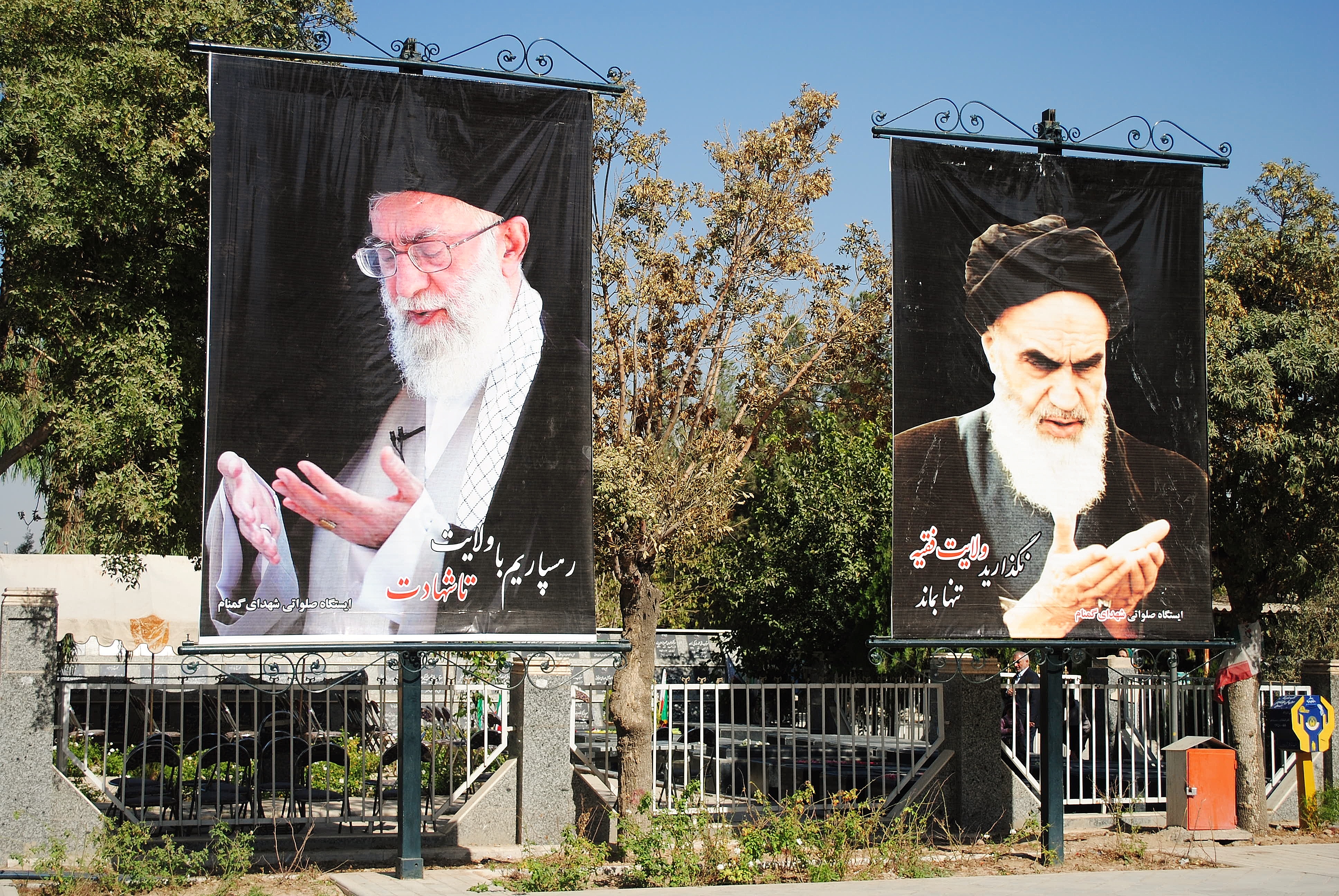
A common sight in Iran. Iranian spiritual leader Ali Khamenei and the former leader Ayatollah Khomeini.
In the building which housed museums there was also a collection of postage stamps and one of them presented the takeover of the American Embassy in Tehran. Hatred of America is felt in Iran in many places and it is a part of the Iranian culture. Even when I was waiting at the gate of Haram a guard asked me if I was not American because if I was he would immediately take a knife on me. Fortunately a Pole is harmless over there. I also had an awkward conversation with my guide about prophet Mohamed and his relationship with a 6 year old girl whom he married when she was 9. I assure that the conversation was difficult for me because of where I was but it was uncomfortable for the student of Islamic philosophy who wanted to defend Islam. He said that this is the issue that knocks out the greatest theologians of Islam but in their opinion if the prophet did it there must have been a good purpose in that. I told him that I didn’t have to be ashamed of Jesus.
To relax from Islam I went to Kuh-e Sangi, a rocky hill surrounded by ponds with a clear view of Mashhad. When we were at the top my guide showed me trees in the lower parts of the city and he said that his regime will one day root them out and put them into Haram, while in the city it will be still difficult to breathe. I realized that although Mashhad is promoted as the centre of Islam, there are people there who have had enough of it. On the way back I saw a man who was travelling with his little daughter, perhaps a 5 year old, and he wrapped her up in black sheets. She was happy because she probably wanted to look like her mother but a few people on the bus looked at her and her father like at a couple of idiots. Mashhad and Iran are therefore very divided.
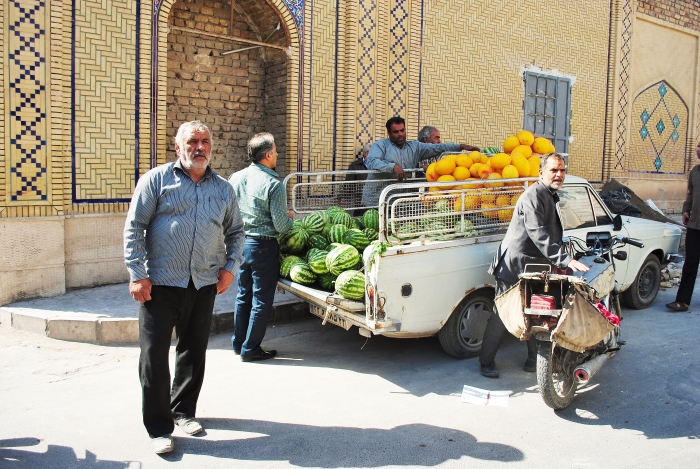
Iran – a street scene.
Iran is of course a huge adventure and that’s why I recommend travelling around that very interesting country, regardless of what you think about Islam and regardless of how brainwashed you are by the Western media. I didn’t expect that Iran would be such a good and interesting country and I liked it so much that in a few years I will probably go back. In my opinion Iran is divided into Persia and the Islamic Republic and this is the way we should understand that country. I also wonder how many mosques and mausoleums to all the “Muslim martyrs” the Iranian regime needs to finally decide that they’ve had enough? On the other hand it is easy to criticize others and that’s why I also wonder how many Muslims, Negroes and faggots does Europe need so the European regime could also decide that they’ve had enough? All regimes are perfectly worth each other in their own ways but it doesn’t change the fact that Iran looks very bad on TV but it is a really valuable tourist destination which I warmly recommend. After Iran I once again realized that under condition of tightly sealed borders I like Muslim countries.
Turkey
I was returning home via Constantinople and unfortunately I missed the connecting flight what at the end did me a great favour. I spent a whole day in Turkey. I saw the Blue Mosque, The Hagia Sophia and I went on the Bosphorus cruise. I was also invited for a cup of tea to a carpet shop what turned out to be an educational experience. It was a one interesting day.
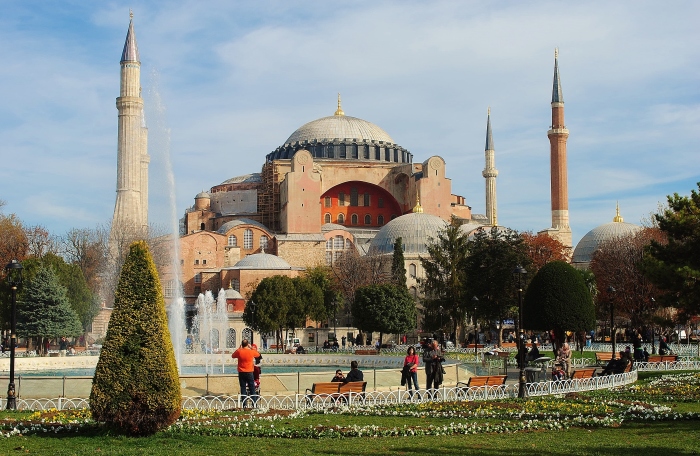
Hagia Sophia Church, Istanbul, Turkey; formerly Constantinople. The present borders of Turkey is a political fiction.
Summary
I consider my expedition to be very successful because I saw even more than I planned, I was travelling two weeks longer and at the same time I managed to close my trip within the planned budget. I would also want to add that these are the regions that do not require huge investment, although I admit that I saved a lot of money by sleeping in a tent from time to time and by moving around by hitchhiking. From my 2013 expedition I have thousands of photos and a lot of souvenirs. I returned on the 11/11/13.
————— ♦ —————
West Asia 2013 – important facts from this expedition
Armenian genocide carried out by Muslim Turks
During my trip to Armenia, whilst in Yerevan I went to the Monument and the Museum of Armenian Genocide (Tsitsernakaberd). It is a moving, tragic place exposing the crimes carried out by Turks against Armenians in the years 1915 – 1917. The museum is the irrefutable evidence what Muslims are capable of when it comes to the final solution for Christians. The Muslim evil brutally murdered about 1.5mln Christians massacring them in the streets, burning their houses, churches, destroying their cultural heritage and raping their women on a mass scale. One of the many brutal methods used by the Ottomans, in addition to burning them alive inside their churches, public hanging and slavery until death was taking Armenians to the sea and then throwing them overboard. The museum presents shocking images and clear evidence of brutality against Armenian Christians. In the museum there are pictures of starving children, mass corpses, human parts, photos of burned churches and an animal like transport in which Turks transported Armenians to the slaughter. To this day the Turkish Government and its little brother – Azerbaijan arrogantly deny that the Armenian Genocide also called the Armenian Holocaust ever took place.
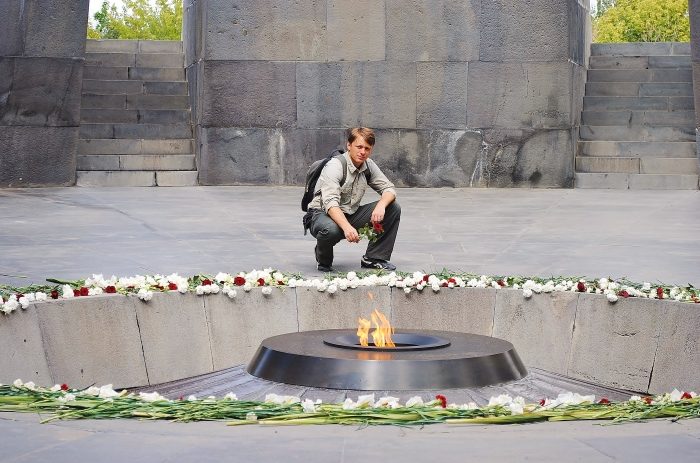
Armenia – I lay flowers at the monument erected in the memory of the victims of the Armenian genocide carried out by Ottoman Turks. I advise everyone to research this matter deeper in order to understand better the tragedy and brutality in which Muslims were killing Christians.
‘The axis of evil’
We’ve all heard the horror stories in the media about Iran as the “axis of evil” and that it works on nuclear weapons. I find these stories to be exaggerated thrillers for naive children, in which unfortunately whole nations believe. I assure everyone that behind all lies always hides economics and lust for power.
According to Goldman Sachs Iran has the potential to be one of the most powerful economies of the twenty-first century, which is why the West fearing for its influence wants to stop Iran’s economic growth because it would have a disastrous effect on them. Where diplomacy does not help military force does and by taking the natural resources, by setting up economic control and by building strategic advantage in someone else’s region the West guarantees itself economic growth. Besides, paying for the army and investing billions each year in new weaponry, in some countries is genuinely for defensive reasons but in others countries it is an investment which must pay back; and such country is the USA. Despite this I think that it would be still better if Muslim countries did not have nuclear weapons although I don’t understand why Pakistan had not been stopped.
When it comes to accusing Iran of terrorism I believe that to some extent it is true but I also believe that the West is perfectly worth Iran because politics is a story that lacks a positive character. I also believe that any acts of terrorism organized by Iran are a direct response to the Western politics, whilst Muslim terrorism does not come from Iran but mainly from countries allied with the United States, such as: Pakistan, Saudi Arabia, Egypt and Afghanistan.
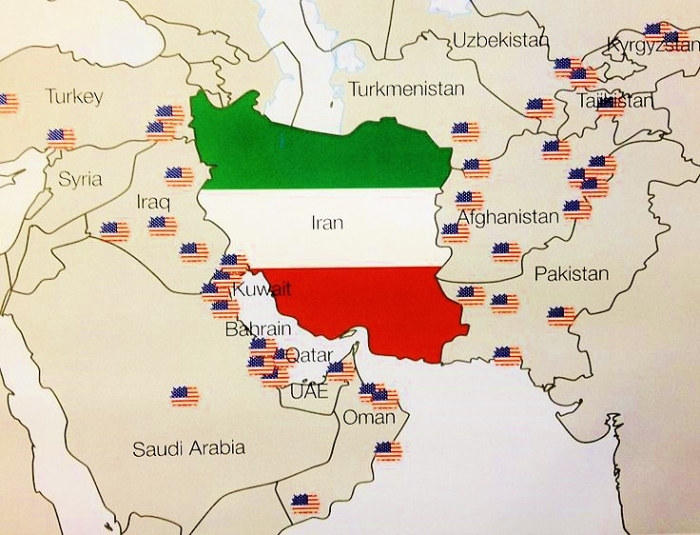
The United States has more than 40 military bases in all Muslim countries around Iran. In addition, the US has a destroyer and submarines in the Persian Gulf carrying nuclear warheads, and there is also the unlawfully established military base called Israel, which burns with hatred for Iran. Therefore, who is a threat to whom ???
When it comes to cutting off Iran from the rest of the world I see it in the following way: the U.S. captured Iraq and Afghanistan and has military bases in almost every Arab country and it has the military base of Israel. This means that Iran is cornered and cut off from the world. Let’s imagine that Iran would have enough military and enough political and medial power to conquer Canada and Mexico, plant a huge army in Cuba and destroyers and the Gulf of Mexico. Then Iran would cut off the U.S. from the rest of the world and it would call it the “axis of evil”. This is exactly what America is doing to Iran for its own economic benefits. Meanwhile, stupid American and British people believe that Iranians are born evil. People would believe anything.
- Ananuri
- Armenia Goshavank
- Armenia-Azerbaijan war
- Ayatollah Khomeini
- Azerbaijan Heydar Aliyev
- Baku Azerbaijan Baku
- Bam earthquake
- Caucasus
- Caucasus Christianity
- churches in Armenia
- churches in Georgia
- culture of ancient Persia
- Davit Gareja
- expedition to Armenia
- expedition to Georgia
- expedition to Iran
- Gelati
- Gori Stalin museum
- Iran Islamic Republic
- Iran mosques
- Kandovan
- Kashan merchants' houses
- Kazbegi Tsminda Sameba
- Matsometa
- Nagorno-Karabakh
- Persepolis
- Persian Gulf
- Qeshm island
- Qobustan petroglyphs
- Shiraz
- Shiraz Aramgah-e Hafez
- Tatev
- Turkey Armenian Genocide
- Yazd old town


































